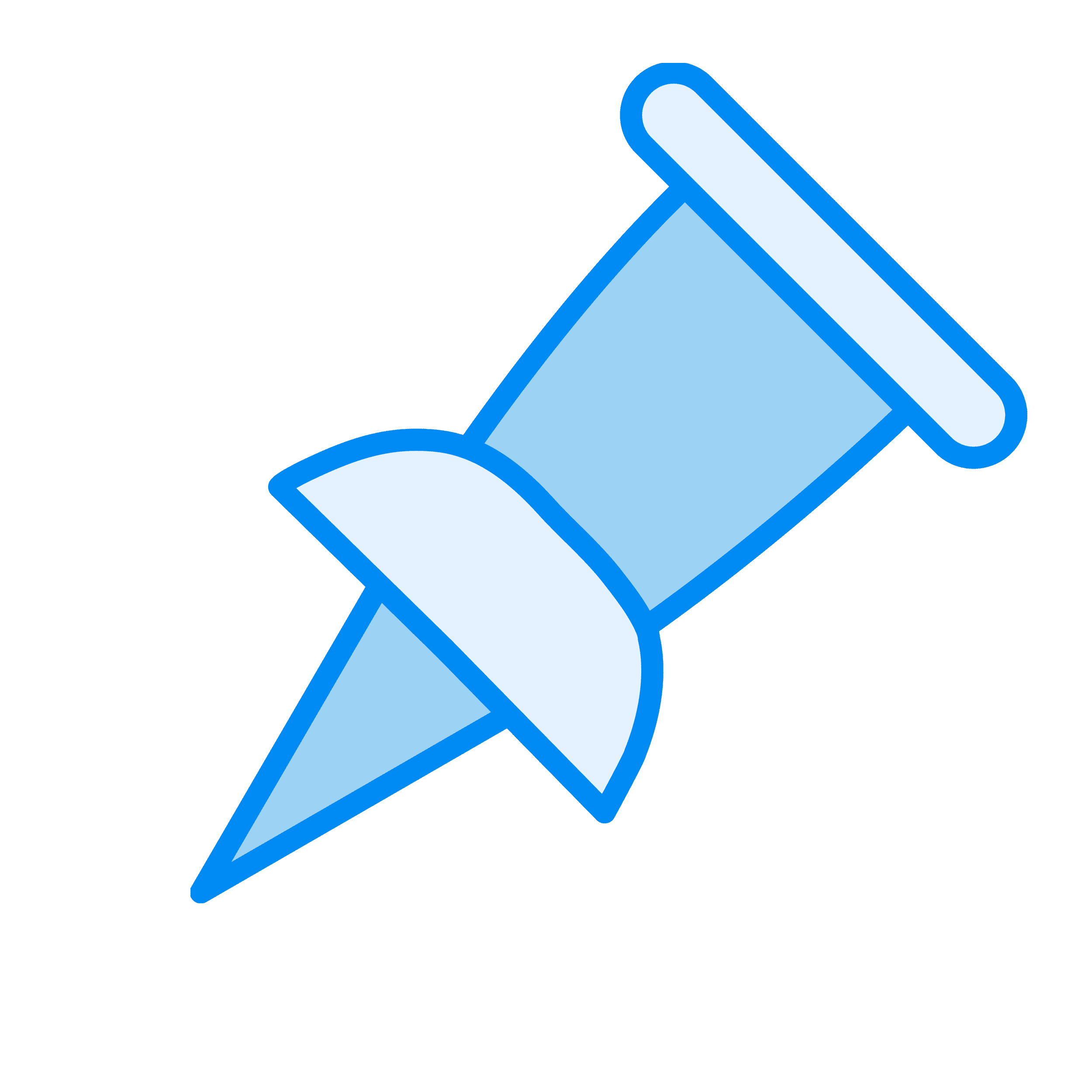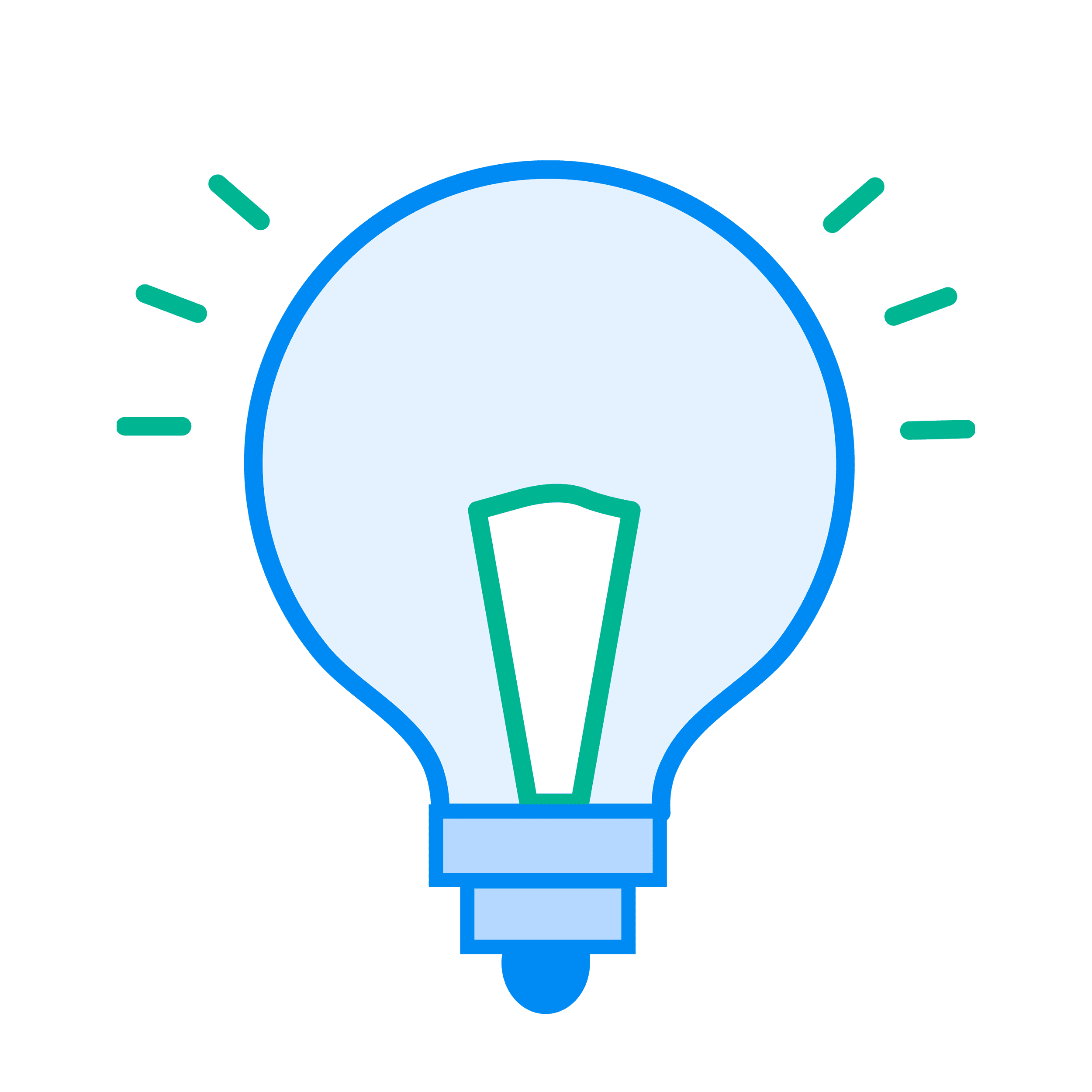E-E-A-T in the AI Era: Complete Guide + Free Audit

Written by Leigh McKenzie

Google E-E-A-T stands for Experience, Expertise, Authoritativeness, and Trustworthiness.
It’s a framework that Google uses to evaluate the quality and credibility of content.
| Google E-E-A-T | Description |
|---|---|
| Experience | Refers to the extent to which the content creator has the necessary first-hand or life experience required for the topic |
| Expertise | Reflects the author’s level of knowledge or skill on the topic |
| Authoritativeness | Measures the extent to which the content creator or the website is known as a go-to source and is well-established and respected in the field |
| Trustworthiness | Assesses the level of accuracy, honesty, safety, and reliability of the website |
Free Template: Download the E-E-A-T Evaluation Guide: 46-Point Audit
But understanding E-E-A-T in the AI era means recognizing it now serves a dual purpose.
It helps you rank in Google and increases your AI search visibility.
In How to Create an SEO Strategy, I share examples, experiments, and campaigns we use at Backlinko to drive results.
This type of content naturally meets the standards of E-E-A-T.
The result?
It consistently ranks at the top of Google for the keyword “SEO strategy.”
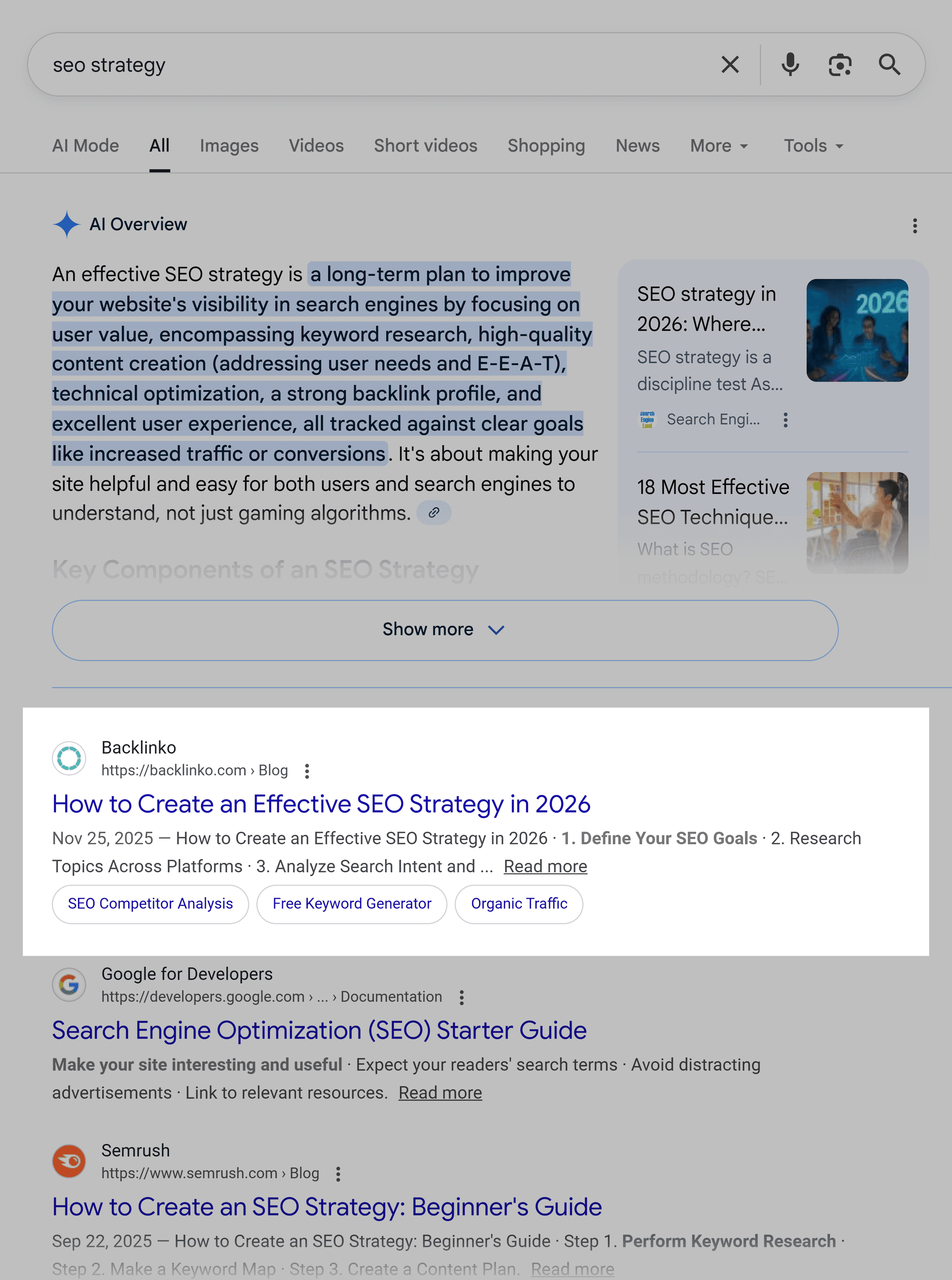
But it’s also helping us get cited by AI platforms.
When someone searches “how to create an SEO strategy” in Perplexity, Backlinko appears as a source.

That’s E-E-A-T working across both systems.
Search rankings show you options and let you decide. AI platforms synthesize, interpret, and frame — referencing sources they deem trustworthy enough to inform their answers.
This changes the stakes.
Search engines interpret your E-E-A-T signals to rank you. AI platforms interpret them to describe you.
After reading this guide, you’ll know:
- What E-E-A-T isn’t
- Why Google and AI platforms prioritize E-E-A-T
- The core elements
- Practical ways to build and demonstrate E-E-A-T
- Red flags that hurt your credibility
What E-E-A-T Isn’t
E-E-A-T is often misunderstood, overcomplicated, and ignored.
Let’s set the record straight.
Myth #1 – E-E-A-T Isn’t a Ranking Factor
Despite its importance, E-E-A-T isn’t a ranking factor.
To understand this better, let’s go back.
E-E-A-T isn’t something new. Google introduced the concept of E-A-T (more on its evolution into E-E-A-T in a minute) in its Quality Rater Guidelines in 2014.
Google’s Quality Rater Guidelines are used by the search engine’s independent evaluators known as “Quality Raters.”
“Raters assess how well content fulfills a search request, and evaluate the quality of results based on the expertise, authoritativeness, and trustworthiness of the content. These ratings do not directly impact ranking, but they do help us to benchmark the quality of our results and make sure these meet a high bar all around the world.”
E-E-A-T isn’t a ranking factor in the way we traditionally think of ranking factors.
Instead, think about Google E-E-A-T as a mindset for creating helpful and people-centric content.
It’s about providing what folks expect from your website. Which helps them trust you.
Myth #2 – E-E-A-T Isn’t a Checklist
As much as we want it to be, E-E-A-T is more nuanced than a checklist of definitions and action items.
Building and demonstrating E-E-A-T doesn’t look the same for any two businesses or niches.
Users browsing different types of content in different niches have different expectations of helpful and trustworthy content.
This couldn’t have been made clearer in December 2022 when Google added an extra “E” to E-A-T to make E-E-A-T.
The additional “E” stands for Experience.
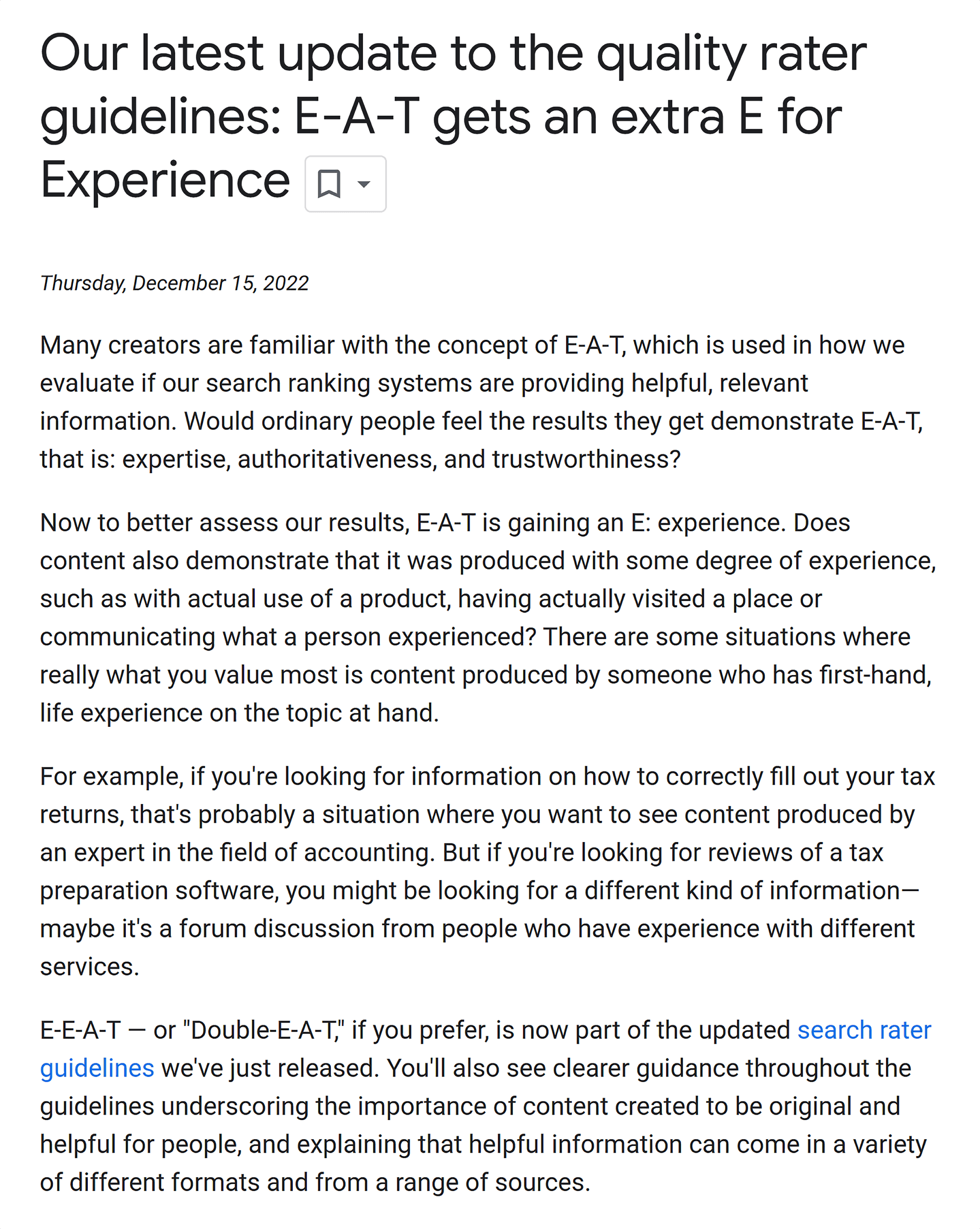
This meant that Google placed more significance than ever on genuine, personal involvement or practical familiarity with the topic covered in a piece of content.
Why?
Users are hungry for insights from people with actual experience on the topic they’re reading about.
But, also, not every topic requires formal expertise for its content to be considered helpful.
Often, first-hand experience means just as much, if not more.
For example, epicgardening.com is regarded as one of the top gardening websites in the world.
It gets an estimated 582.1k monthly organic traffic from 675.5k search rankings.
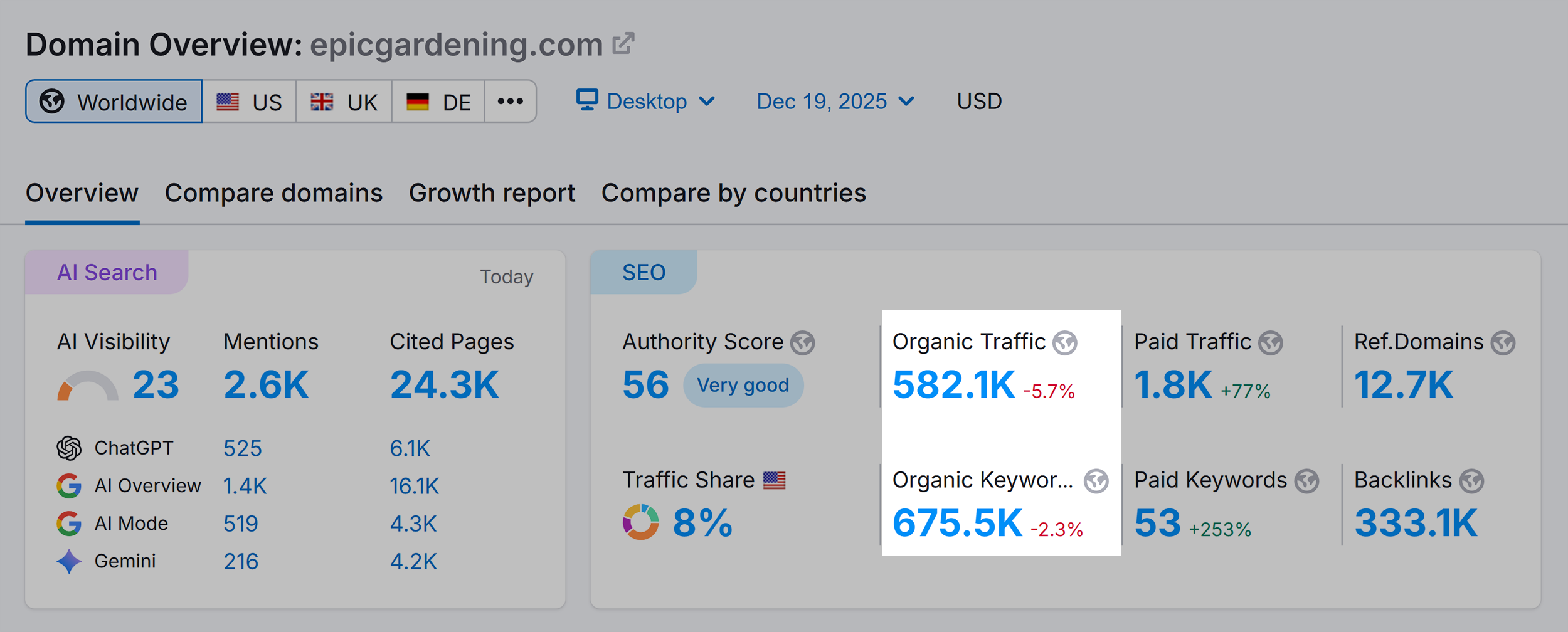
Yet, the founder, Kevin Espiritu, who had no formal qualifications in horticulture or landscaping, built an audience by sharing what he had learned from experimenting in his garden.
Now, Epic Gardening employs a team of gardening experts to produce content and build upon their E-E-A-T.
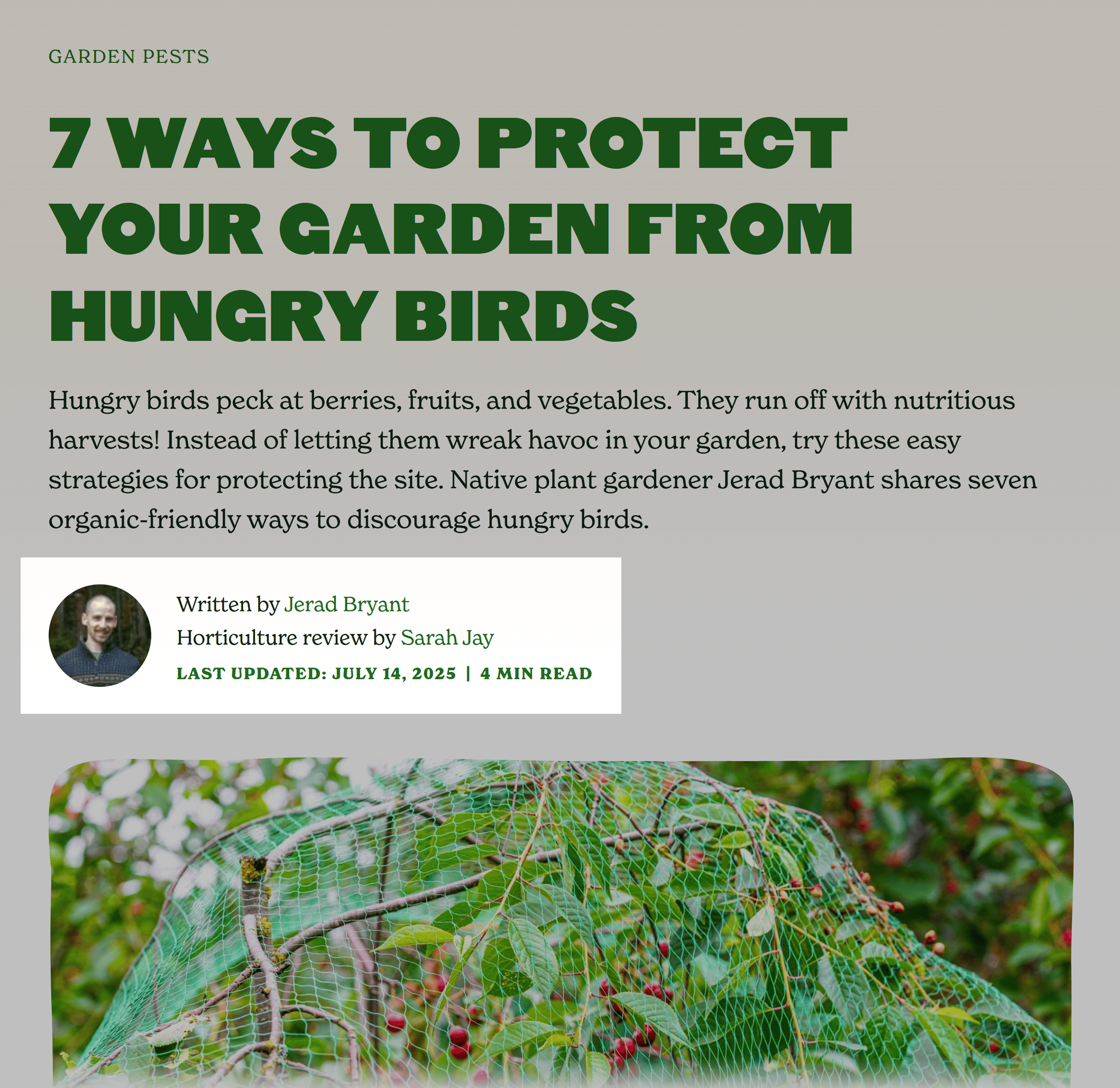
When Google introduced E-E-A-T, it also emphasized that the “T” (trust, just in case you forgot) is the foundation of E-E-A-T and holds huge significance.
And this makes total sense.
Think about it: If users don’t trust your content, what value does it have?
But E-E-A-T isn’t just about demonstrating these four things on your site.
It’s also about making sure they’re shown off-site.
Off-site signals include:
| Backlinks | Speaking engagements | Forum and niche group mentions |
| Branded searches | Podcast appearances | Social media engagement |
| Press mentions | Reviews and testimonials | Peer recognition online |
A good way to think about showing E-E-A-T is to ensure you share your experience, expertise, authoritativeness, and trustworthiness on-site and confirm this with off-page signals.
Being trusted and considered authoritative is as much about what other people say about you as it is about what you say yourself.
When you break down E-E-A-T into on-page and off-page factors, thinking about practical ways to build and demonstrate it becomes much easier.
Free Template: Download the E-E-A-T Evaluation Guide: 46-Point Audit
Why E-E-A-T Matters
E-E-A-T is one of the ways Google separates authentic, valuable content from thin, low-quality content and generic AI output.
With AI usage growing by the day, it’s easier than ever to mass-produce content not written by someone with firsthand experience or expertise.
A few years back, SEO expert Matt Digity exclusively used AI to create 526 articles for a new website.
The website cracked 50,000 sessions per month.
Google knew this was happening.
And it got better at spotting manufactured content versus content created by real people with real experience.
Google’s Quality Raters evaluate content based on E-E-A-T principles.
Their feedback trains Google’s ranking algorithms to recognize quality content automatically.

Pages that demonstrate strong E-E-A-T consistently get higher quality scores. Those scores influence rankings.
Translation?
The better you demonstrate experience, expertise, authority, and trust, the more likely Google is to rank your content.

But Google’s ability to evaluate E-E-A-T isn’t just based on what’s visible on the page.
It also depends on how your content connects to known concepts, people, organizations, and topics across the web.
And whether those connections can be verified.
Google does this using entity recognition and vector-based understanding.
- Entities are things like people, brands, locations, tools, or ideas that Google understands as “real” and identifiable.
- Vectors are how those entities and concepts are mapped and grouped based on meaning, relationships, and relevance. Think of it like Google’s way of clustering semantically similar ideas. So, it knows that “Brian Dean” is connected to “Backlinko,” “SEO training,” and “content strategy.”
If your content is filled with vague language or lacks recognizable references, Google may have a harder time understanding — and trusting — what you’re trying to say.
That’s why, in addition to showcasing human signals of trust, like author bios and citations, it’s critical to prioritize Entity SEO (more on this later).
AI systems evaluate E-E-A-T in similar ways.
When ChatGPT, Perplexity, or Gemini decides which sources to cite, they prioritize content from recognized entities and authoritative sources.

They look for the same signals: verified expertise, established authority, and consistent information across platforms.
But there’s a critical difference.
While Google assesses cumulative trust signals through backlinks and long-term reputation, LLMs can weigh recent sentiment and user-generated content more immediately.
A brand mentioned positively across Reddit threads, review sites, and recent articles can gain visibility in AI platforms faster than it might climb traditional search rankings.

Bottom line: As AI platforms become a primary way people discover information, demonstrating E-E-A-T is essential for maintaining your visibility online.
Further reading: 7 Proven Ways to Increase Your Website Authority
The Core Elements of E-E-A-T
Let’s take a deep dive into each of the four elements that make up E-E-A-T.
Experience
When Google refers to “experience,” it means real-world, firsthand involvement with the subject matter of a piece of content.
This could mean:
- The author of a hotel review has stayed in the hotel they’re writing about
- The author of a roundup of “best books,” having actually read each of the books they’re recommending
- The author of a product review has tried and tested the product themselves
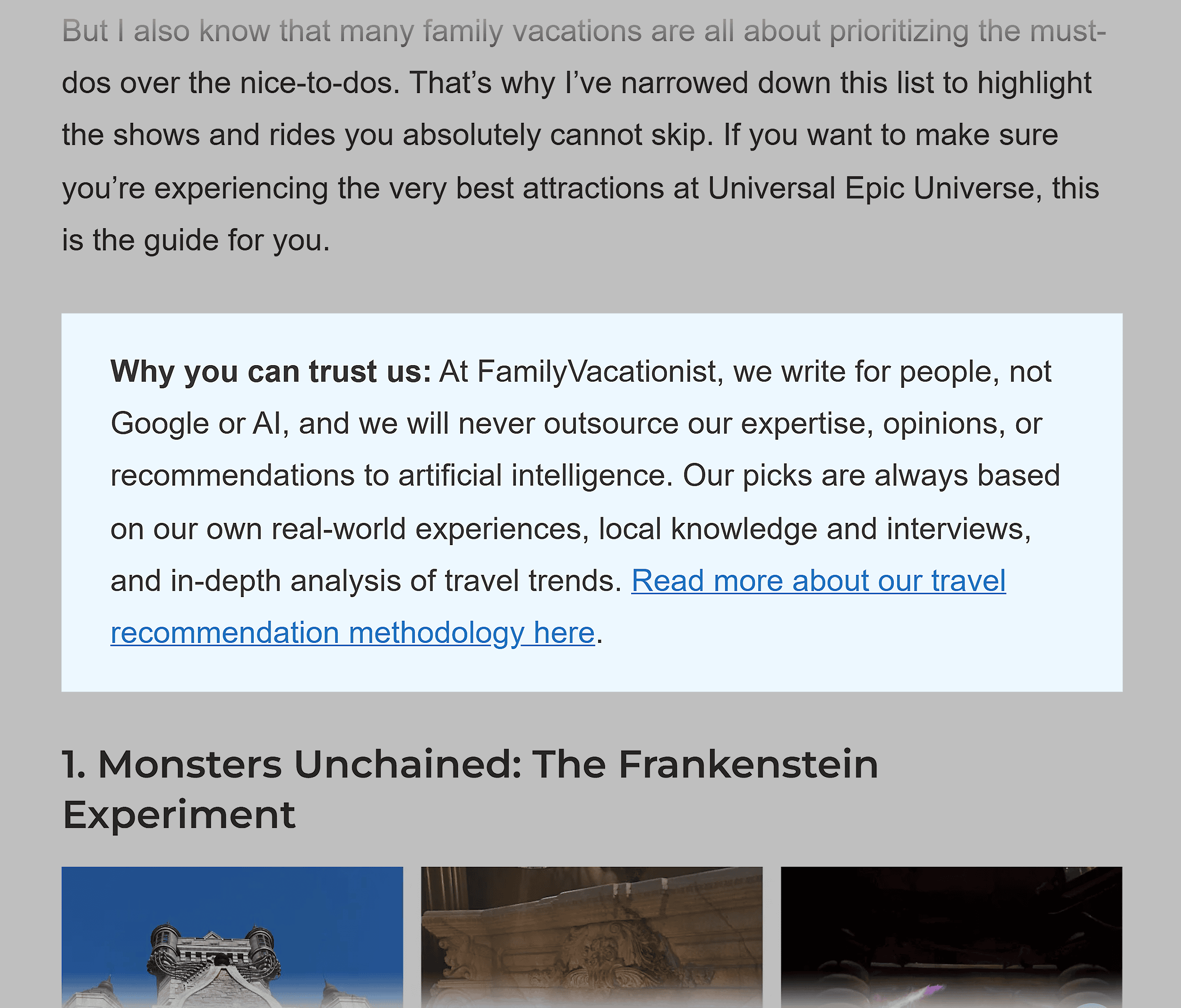
An authentic experience with a subject is (currently) outside the scope of AI capabilities.
While AI might attempt to emulate aspects of human experience, its content lacks genuine uniqueness.
Google views experience as a key factor in distinguishing content created by humans from that generated by AI.
But let’s not forget that it’s also something users expect.
And increasingly, so do LLMs.
Platforms like ChatGPT and Claude frequently pull from user-generated content on Reddit, Quora, and niche community forums when deciding which brands and products to recommend.
These systems are looking for authentic feedback and reviews that demonstrate real experience.
This makes genuine community engagement and real user testimonials more valuable than ever for building experience signals.
Here are some examples Google gives in its Quality Rater Guidelines to highlight when experience is key and when the information or advice is best left to experts:

Expertise
Google sees expertise as tied to the creator of the content. It’s linked to their formal (or informal) education or how they acquired their skills.
Google’s Quality Raters ask questions like:
- Who is the driving force behind the content?
- Is the creator well-versed in the subject matter?
- What is the creator’s standing within the field?
As with experience, expertise’s importance depends on the content type and topic.
Demonstrating expertise is especially important in Your Money, Your Life (YMYL) topics like finance and medicine.
Why?
Because these topics can affect people’s health, happiness, financial stability, or safety.
Your qualifications, academic achievements, and standing within your field are also crucial when creating such content.

However, everyday proficiency can also be classed as expertise for certain topics and types of content.
So, what’s a good way of demonstrating this type of expertise to Google and LLMs?
It may sound straightforward, but write about subjects you know well.
Many sites also rely on expert reviews when writers lack the specific training or education to provide their content with expertise.
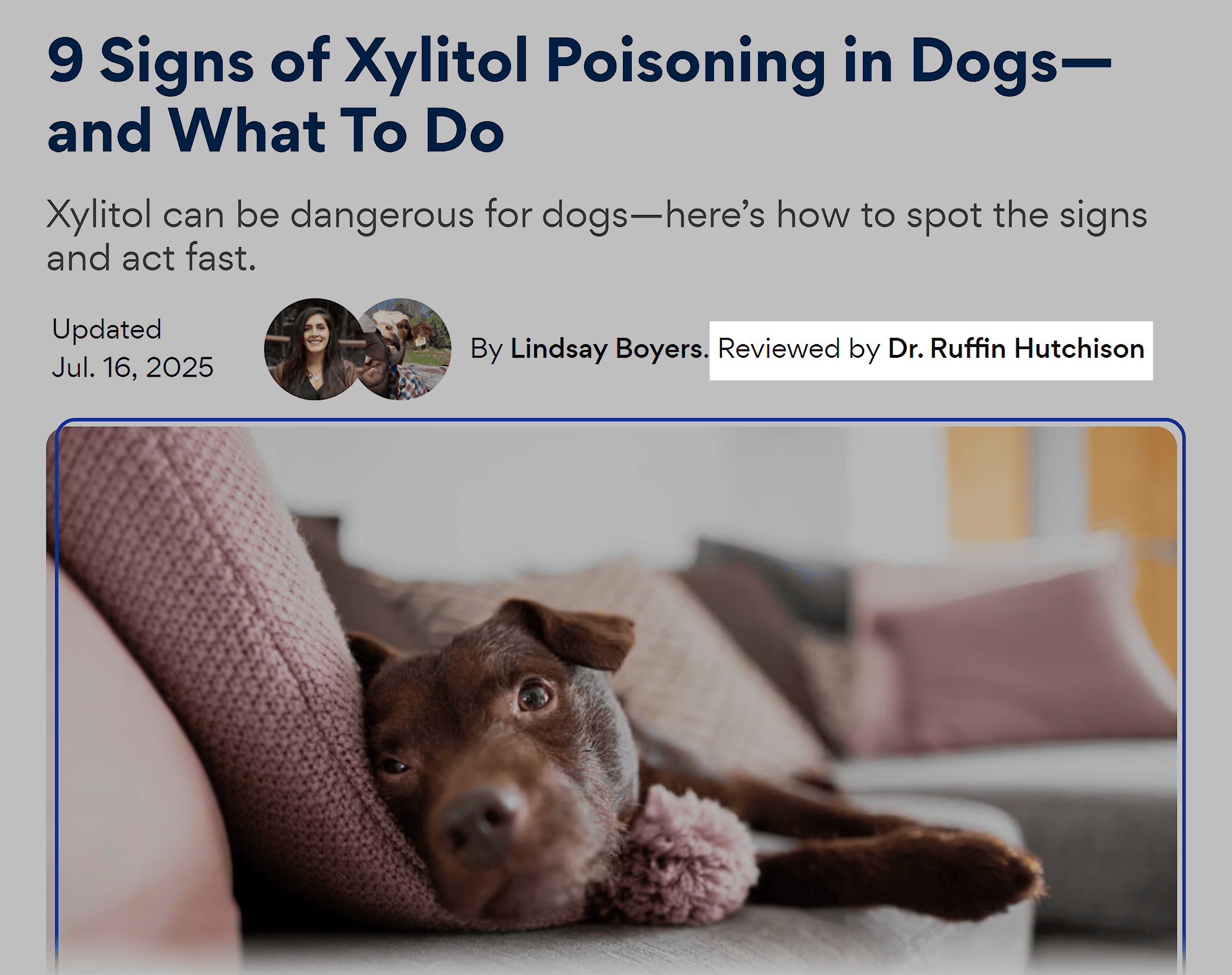
This principle holds true for both Google and AI platforms.
LLMs prioritize content from established experts and authoritative publications when deciding what to cite.
Being quoted in industry publications, earning backlinks from authoritative sites, and building a recognized digital presence all reinforce your expertise signals across traditional and AI search.
Authoritativeness
Authoritativeness refers to how much authority a content creator or site holds.
It means to what extent you’re a go-to source for knowledge on a subject.
Backlinks are still vital for building authority in the AI era.
But they’re just one piece of the puzzle.
True authority comes from multiple signals working together:
- Backlinks
- Positive brand reputation
- Demonstrated expertise
- Proven experience
- Press mentions
- Community recognition
Both Google and AI platforms evaluate all of these when determining who to trust and cite.
For example, the Financial Times is considered one of the most authoritative sources on finance.

Likewise, ESPN has enormous authority within sports.
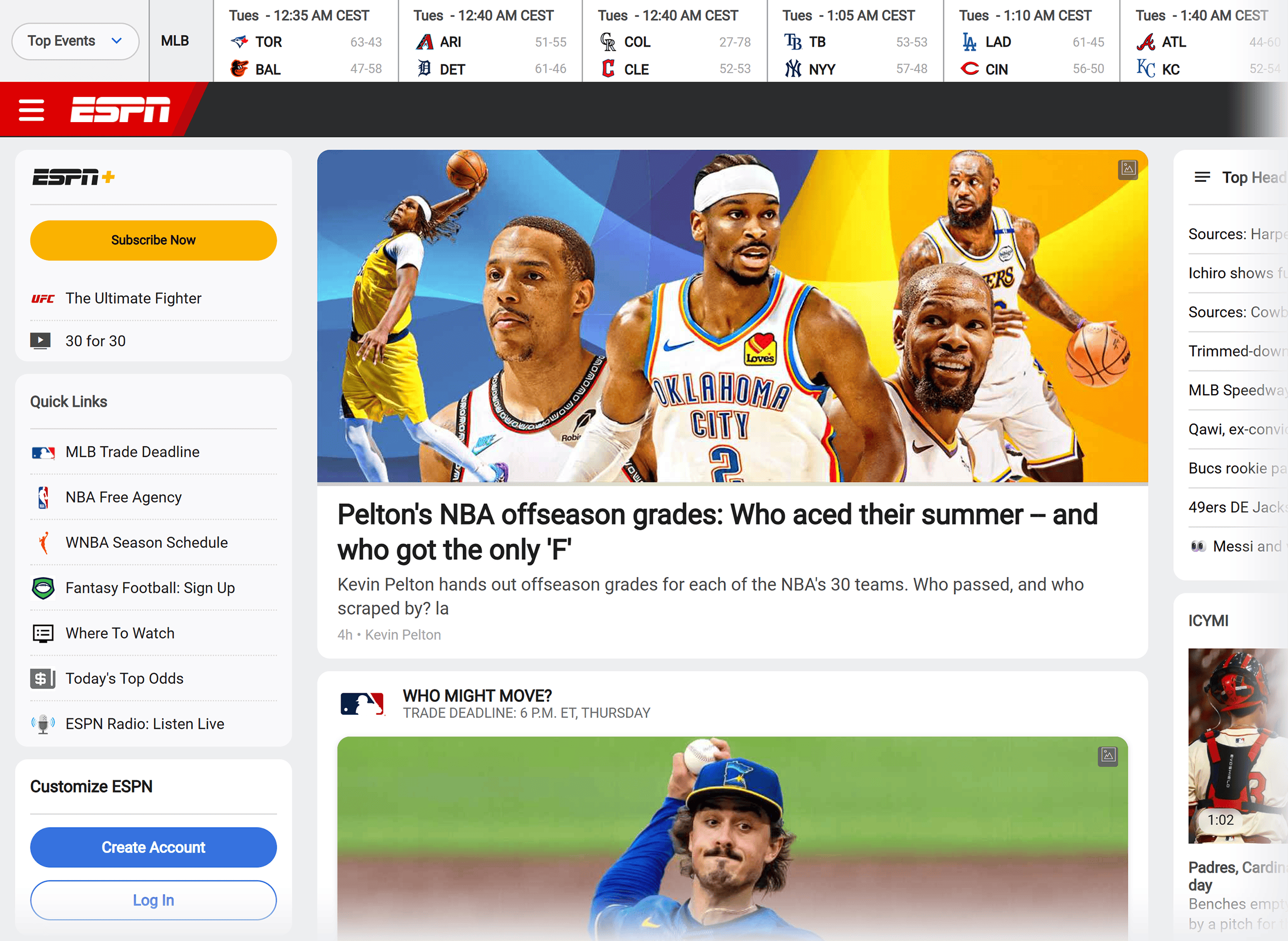
Why is this the case?
Browse any of the articles on sites like these, and the first thing you’ll notice is the massive amount of (you guessed it) experience and expertise on show.
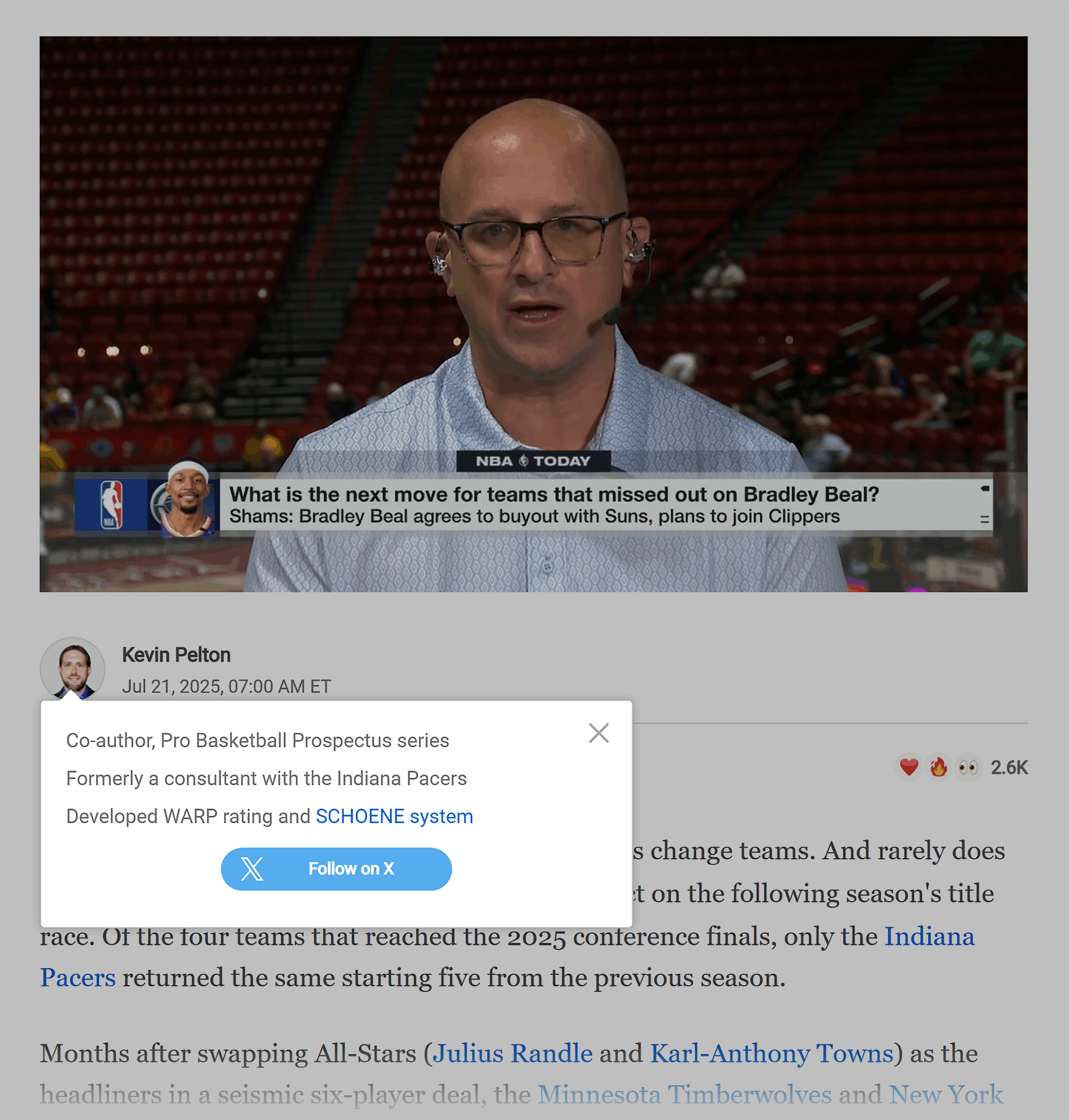
You’ll also notice that these sites have:
- A positive reputation
- Authors with strong personal brands or digital profiles as experts in specific topics
- Strong content architecture that covers all aspects of a particular topic
- Backlinks from other authoritative sites
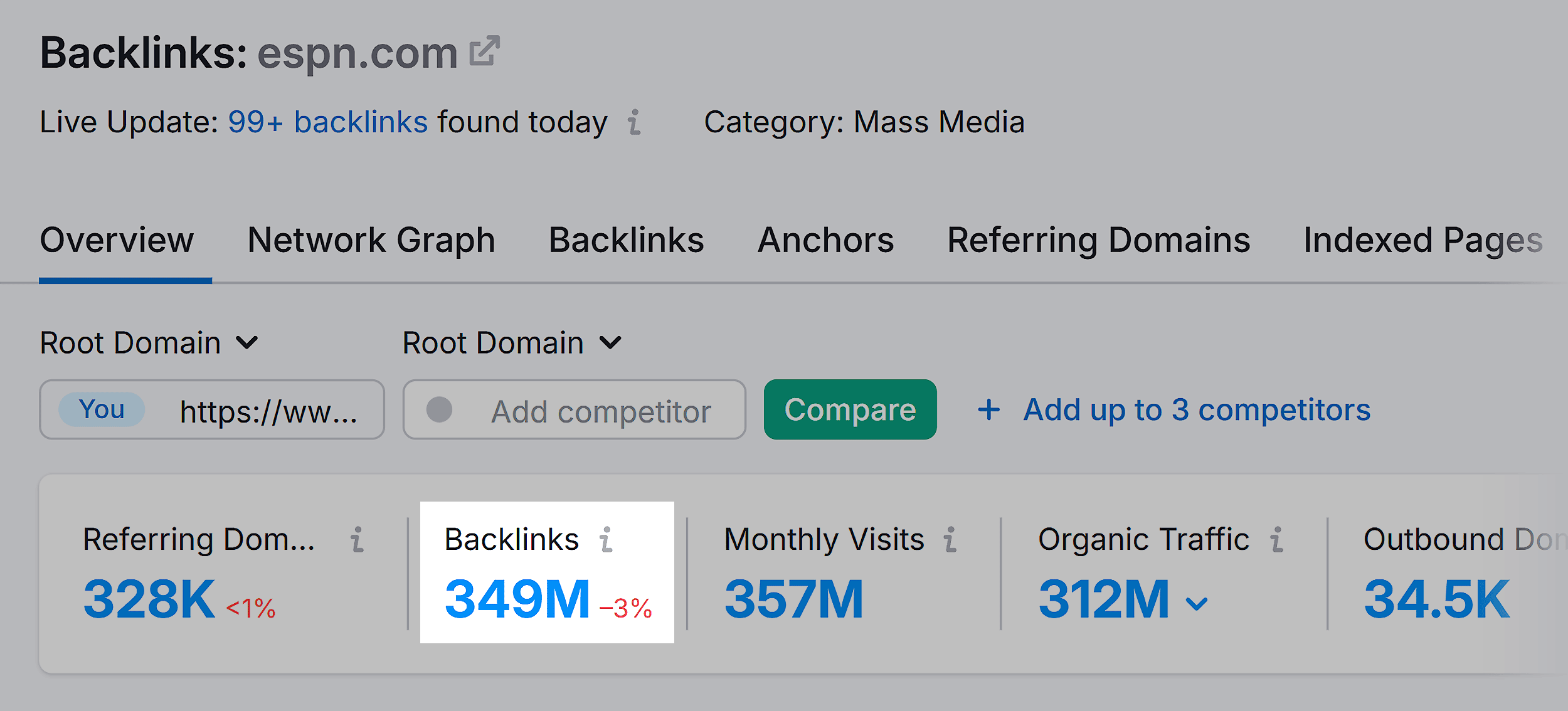
These same signals help AI platforms identify authoritative sources to cite.
When considering authoritativeness, remember that it always goes hand-in-hand with expertise and experience.
If you don’t have any expertise or experience around a topic, then you can’t be a voice of authority on it.
Trustworthiness
Trustworthiness is the most crucial factor in E-E-A-T.
(And Google makes this clear in its Quality Rater Guidelines.)

Google considers your site trustworthy if it’s accurate, honest, safe, and reliable.
Trust signals come from multiple places.
This includes everything from secure online payment options and your site’s user experience to third-party mentions of your brand online.
Still, the importance of trustworthiness to a page or site depends on the type of content.
Google evaluates trustworthiness based on the content’s intended purpose.
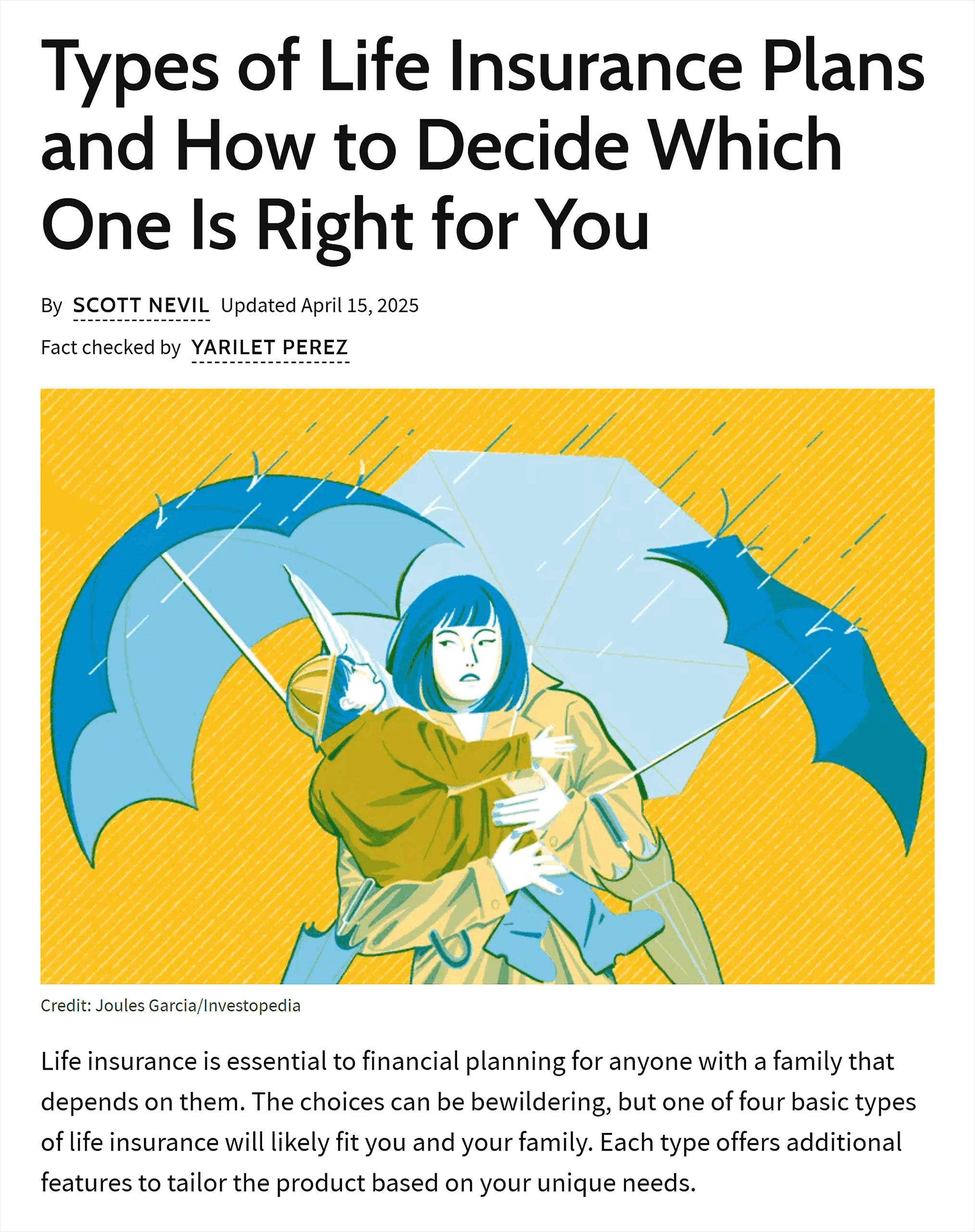
For instance, a page that provides financial information needs to be more trustworthy than a blog post giving an opinion about the best taco spots in LA.
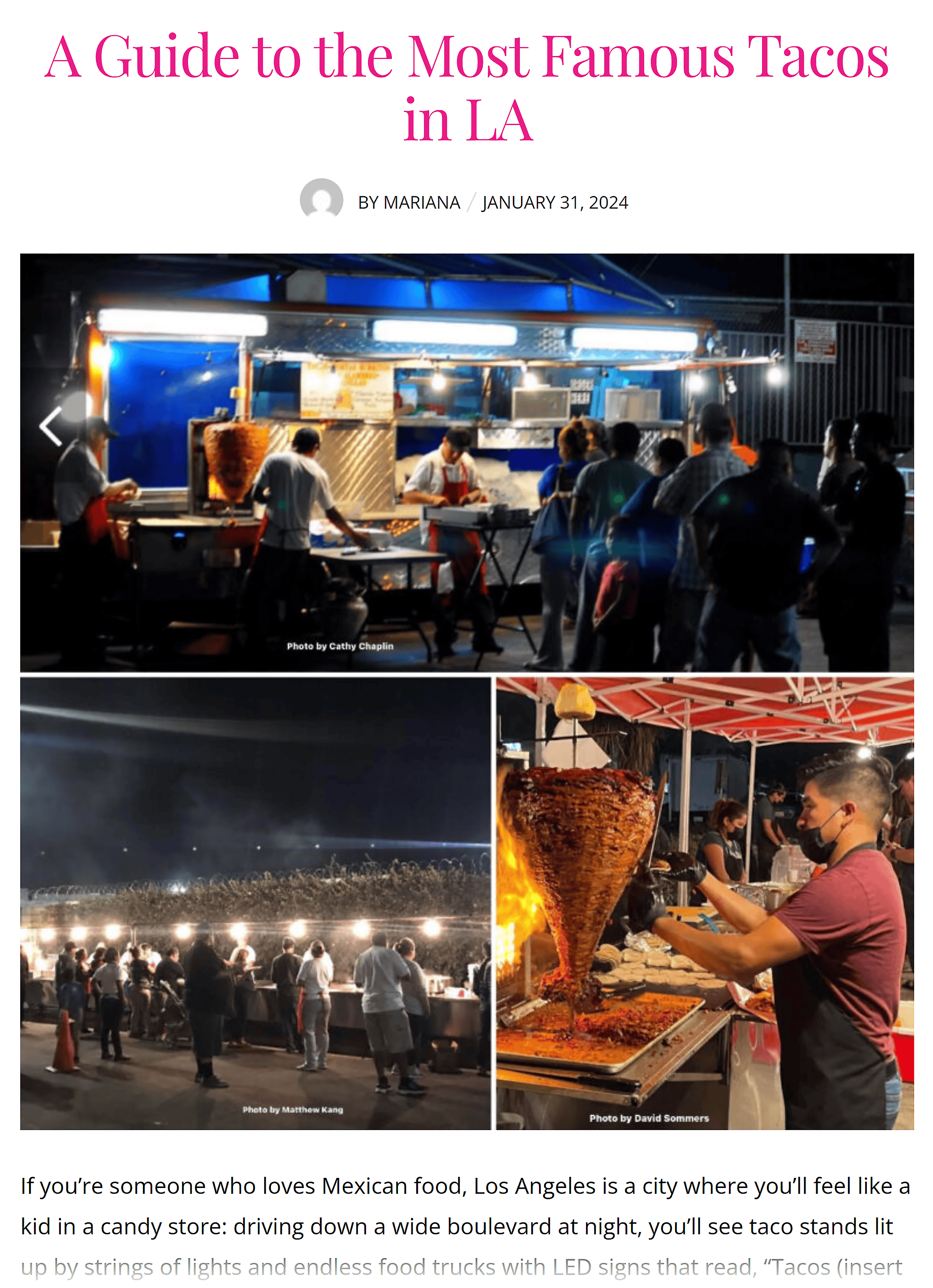
But both still need high-quality content that provides real value. And a safe, secure site.
For AI systems, trustworthiness also depends on how easily they can parse and verify your information.
Structured content — clear headings, logical organization, semantic HTML — helps search engines surface your information more effectively. And since AI systems often pull from search results and indexed content, that structural clarity carries forward.
14 Practical Ways to Build and Demonstrate E-E-A-T
Building and demonstrating E-E-A-T in the AI era doesn’t have to be difficult.
And there are many things you can do to make this happen.
Here are 14 practical ways to help build your site’s reputation and align with how Google views your website’s E-E-A-T.
1. Leverage Experts and People with Firsthand Experience
Think carefully about who authors your site’s content.
Ideally, this should be an expert from within your business who is knowledgeable about the topic and has sufficient experience or expertise to write about it.
Ask yourself questions like:
- Who in the business is the most experienced to write about this topic?
- Who do we want as a spokesperson on this topic?
- Who can commit to sharing insights, comments, and thoughts on the topic?

Sometimes, you’ll have more than one person within the business who meets this criteria. Great!
Can’t get these people to commit to writing the content?
Schedule regular time with them each month to help you add value by providing quotes and reviewing content and competitor pieces to identify gaps.
This is what we do at Backlinko — our internal team often provides input on outlines and drafts.
They also share expert insights for our articles based on their expertise.

So, don’t fall into the trap of publishing authorless content.
Readers want to know who the person behind the content is.
This means that you shouldn’t publish content assigned to ‘admin.’
For example, home services company Angi has industry experts write and review its articles.
Like this one on the cost of shiplap:

Click on the byline and you’ll learn the writer is a construction pro with over 30 years of experience:

This immediately tells the reader and Google that this content is full of E-E-A-T.
As a result, the article ranks highly on Google for “shiplap ceiling installation cost” and other related terms.

LLMs like Perplexity also use it as a reputable source when users search for information on shiplap costs.

The easier you make it for readers and AI bots to see who is behind your content, the better.
But don’t forget, experience and expertise are different things. Some topics need formal expertise.
But, often, you can show high E-E-A-T with experience.
2. Encourage Authentic Community Engagement
User-generated content plays a considerable role in building E-E-A-T signals that Google and LLMs recognize.
This is because users share authentic feedback and recommendations on platforms like Quora and Reddit.
Google then pulls from these UGC forums to inform search results.

And LLMs do the same when determining what to recommend.

When real customers discuss their experiences with your brand in community forums, review platforms, or Reddit threads, these conversations become powerful E-E-A-T signals.
AI systems prioritize this authentic, unfiltered content because it demonstrates real-world experience.
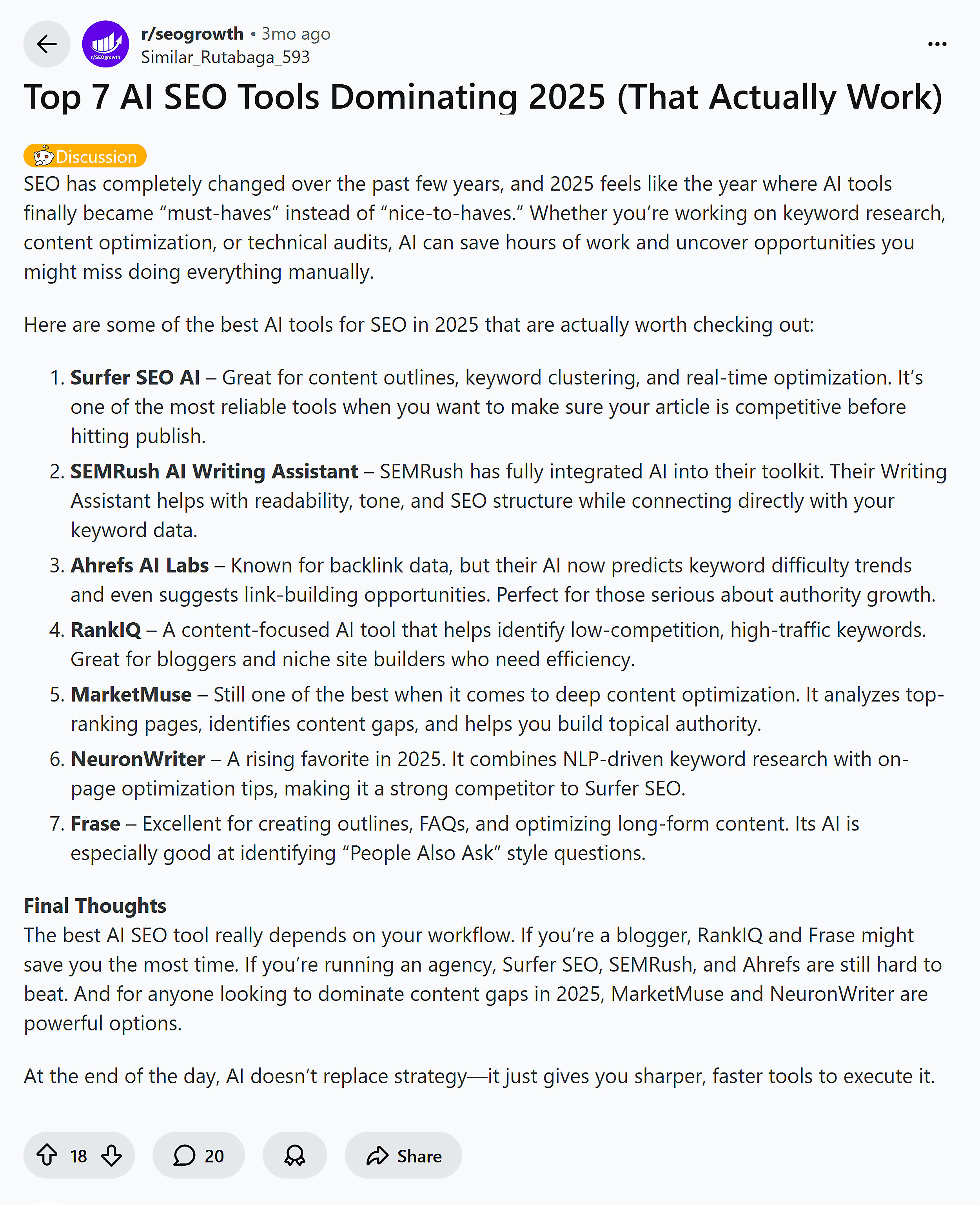
Here’s how to build UGC signals:
- Make it easy for customers to share their experiences: Send post-purchase emails with direct links to review platforms like Trustpilot, G2, Capterra, Yelp, TripAdvisor, and relevant communities, depending on your niche
- Respond to all brand mentions: Monitor discussions where your brand is mentioned and join conversations with helpful, honest responses. The goal isn’t to control the narrative; it’s to add genuine value.
- Share expertise in relevant communities: Have your team participate in industry subreddits. Answer questions and share insights that help others.

3. Add Value Beyond What’s Already Present in the SERPs
The majority of online content is simply people rehashing the same content over and over again.
Often, this content ranks at the top of the SERPs.
We call this copycat content.
A great way of demonstrating E-E-A-T to Google is to fill a knowledge gap by bringing something new to the table.
This is known as information gain.
There are many ways to add information gain to your content:
- Original data, surveys, or research from your own experiments
- First-person case studies with specific results and screenshots
- Expert quotes and insights not found in competing articles
- Original frameworks, processes, or step-by-step methodologies
- Personal experiences, mistakes, and lessons learned that others haven’t shared
These elements help you rank in Google and make your content more likely to be cited by AI platforms looking for authoritative, original sources.
For instance, there are tons of articles online about the best blog niches.

But most don’t have any actual data to back up their claims.
So, we created our own version, complete with a scoring system.

We ranked the top 25 blog niches based on search volume data, keyword difficulty, and other key metrics.
And we explained our methodology in detail in the blog post.
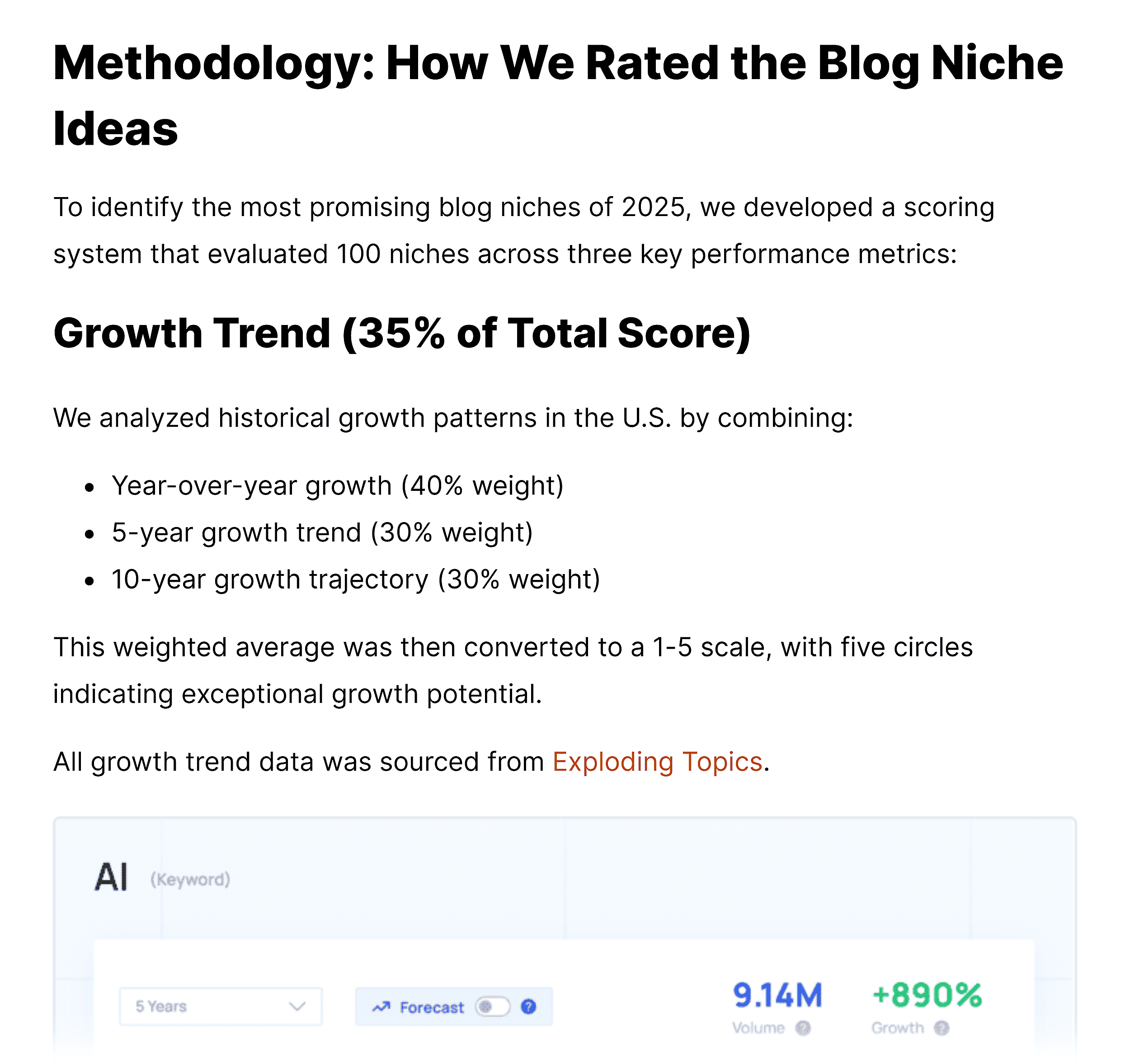
This helps our content stand out on the SERPs and tells Google we are bringing something new — and valuable — to the table.
It’s also earning us mentions in LLMs like ChatGPT:
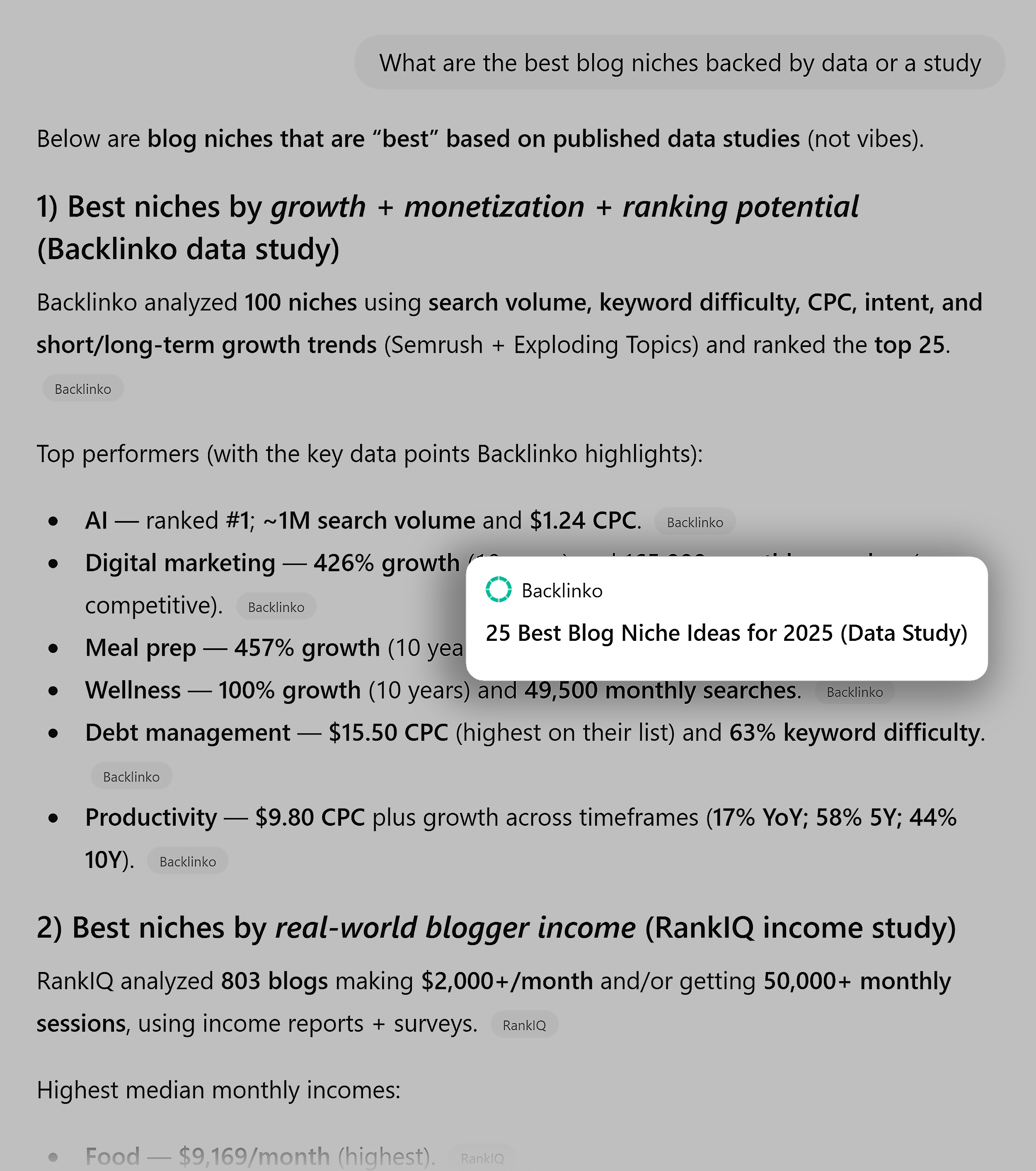
4. Optimize for Entity Signals
Remember those entity signals we discussed earlier?
There are multiple ways to strengthen them.
This includes using related words and topic phrases.
For example, instead of just targeting “SEO,” you’d include related terms:
Like “search engine optimization,” “organic traffic,” “SERP rankings,” and “keyword research.”
A keyword research tool like Semrush’s Keyword Magic can help you find these terms.
Note: A free Semrush account gives you 10 searches in this tool per day. Or you can use this link to access a 14-day trial on a Semrush Pro subscription.
Here’s how to use it:
Type in your seed keyword (for example, “cycling”), and hit “Search.”

You’ll then get a list of keywords related to your seed keyword, along with their monthly search volume and keyword difficulty scores.
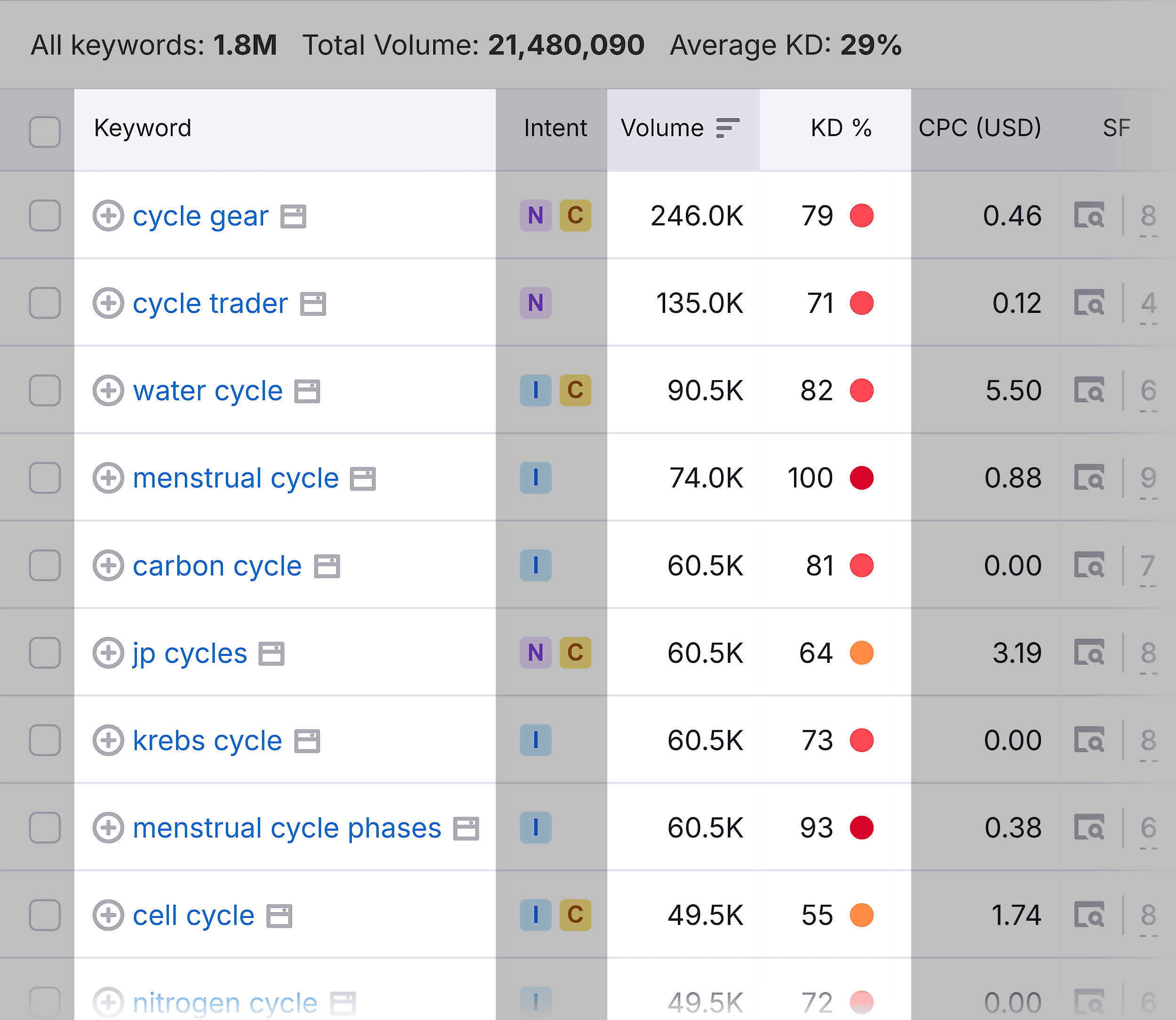
On the left, there are different groups of keywords. These are subtopics related to your seed keyword.
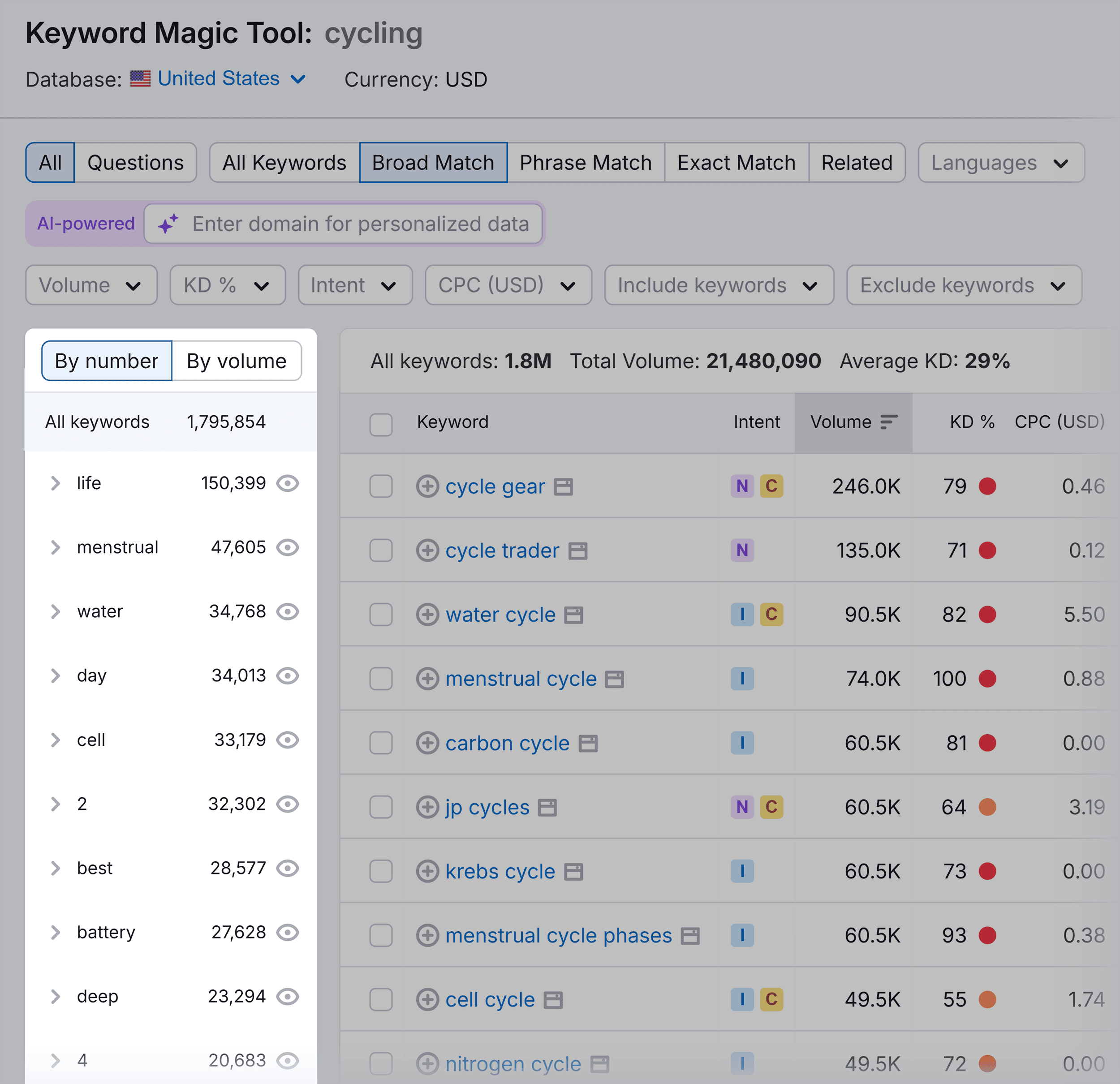
If you click on one of these subtopics, such as shoes, you’ll get a list of keywords related to your seed keyword and the subtopic.
For example, “indoor cycling shoes.”
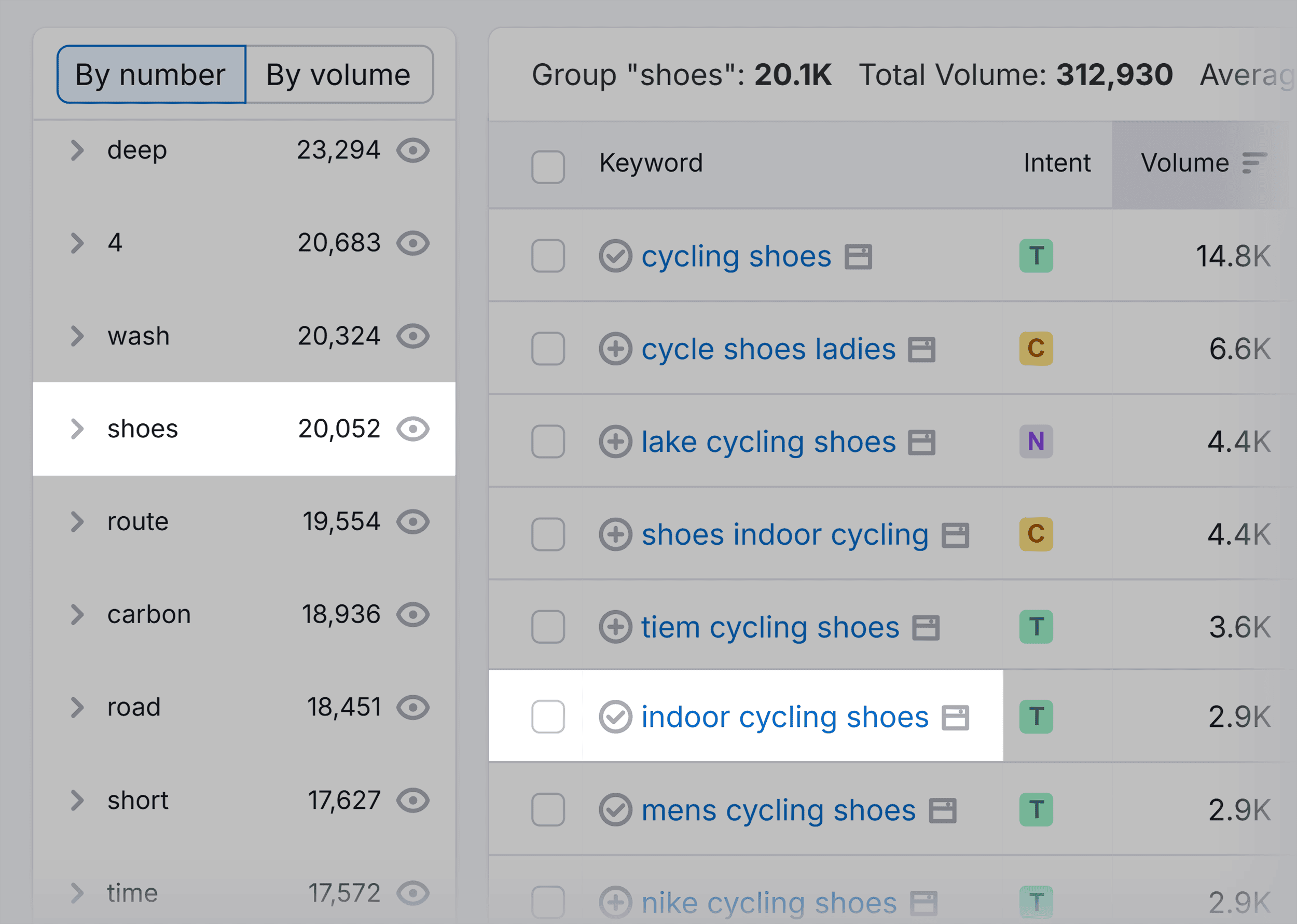
Now, you’ll have a significantly larger number of keywords to choose from to create content around.
A few other ways to optimize for entity signals include:
- Writing SPO (subject–predicate–object) statements: Clear statements like “Yoast (subject) develops (predicate) SEO plugins for WordPress (object)” help Google understand relationships between entities. Use them in author bios, about pages, product pages, schema markup, and key takeaways.
- Building author pages and cross-linking topically related posts: Create clear connections between your content, authors, and topics with internal links
- Include attributes and features commonly associated with your entity. For example, if your brand is known for a unique methodology, term, or framework, mention it regularly in your content, schema, and media coverage. This strengthens Google’s understanding of your brand.
For example, Brian Dean is known for creating the skyscraper technique, a content strategy designed to attract high-quality backlinks.
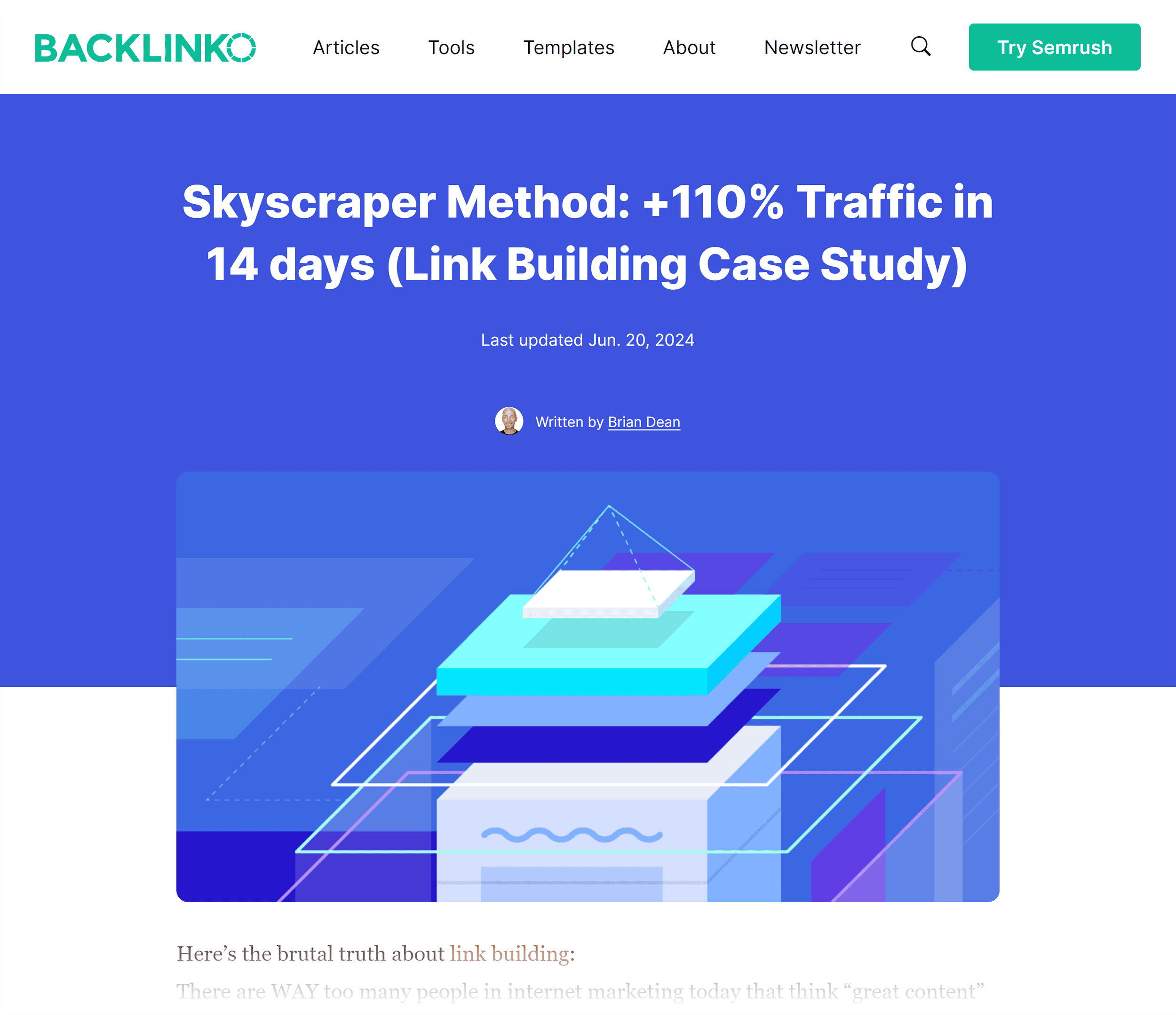
Over time, this technique has become synonymous with his name.
It’s frequently cited across leading SEO blogs, forums, YouTube videos, and AI systems.

By consistently publishing and referencing this method in his content, presentations, and interviews, Brian has reinforced that association.
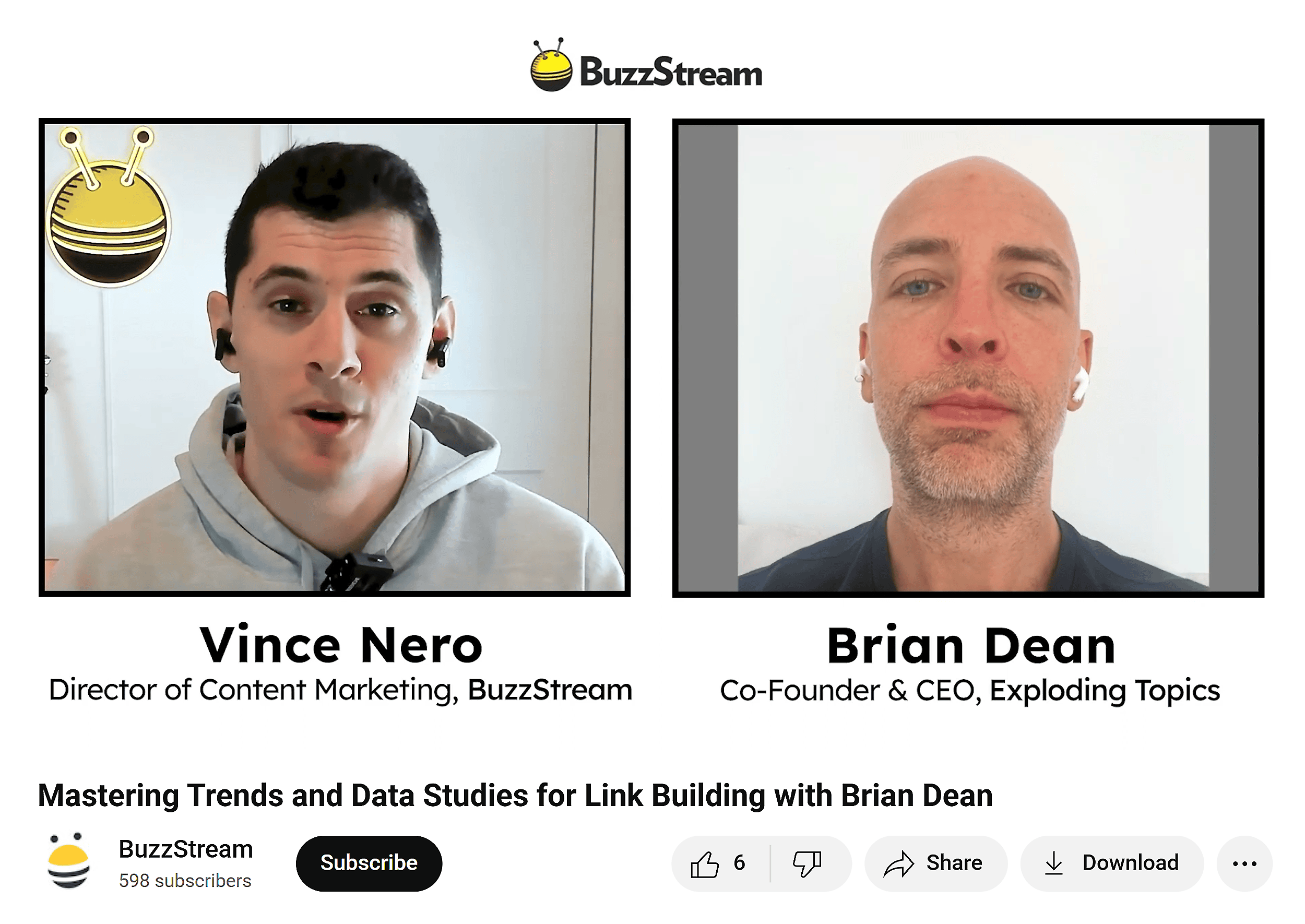
So, Google, users and LLMs recognize him as the original source and a leading authority in SEO and content strategy.

5. Establish a Positive Brand Reputation
A positive brand reputation goes a long way in helping people trust you.
Which helps increase your traditional search and AI visibility.
On the flip side, if your brand has a negative reputation, this can make you untrustworthy.
And one of the best ways to build a positive reputation is to gather reviews and testimonials.
To get positive reviews and testimonials, though, you need to make sure your service, products, and the overall customer experience are great.
Depending on the type of business you operate, encourage reviews on platforms like Trustpilot and Yelp, as well as your Google Business Profile.
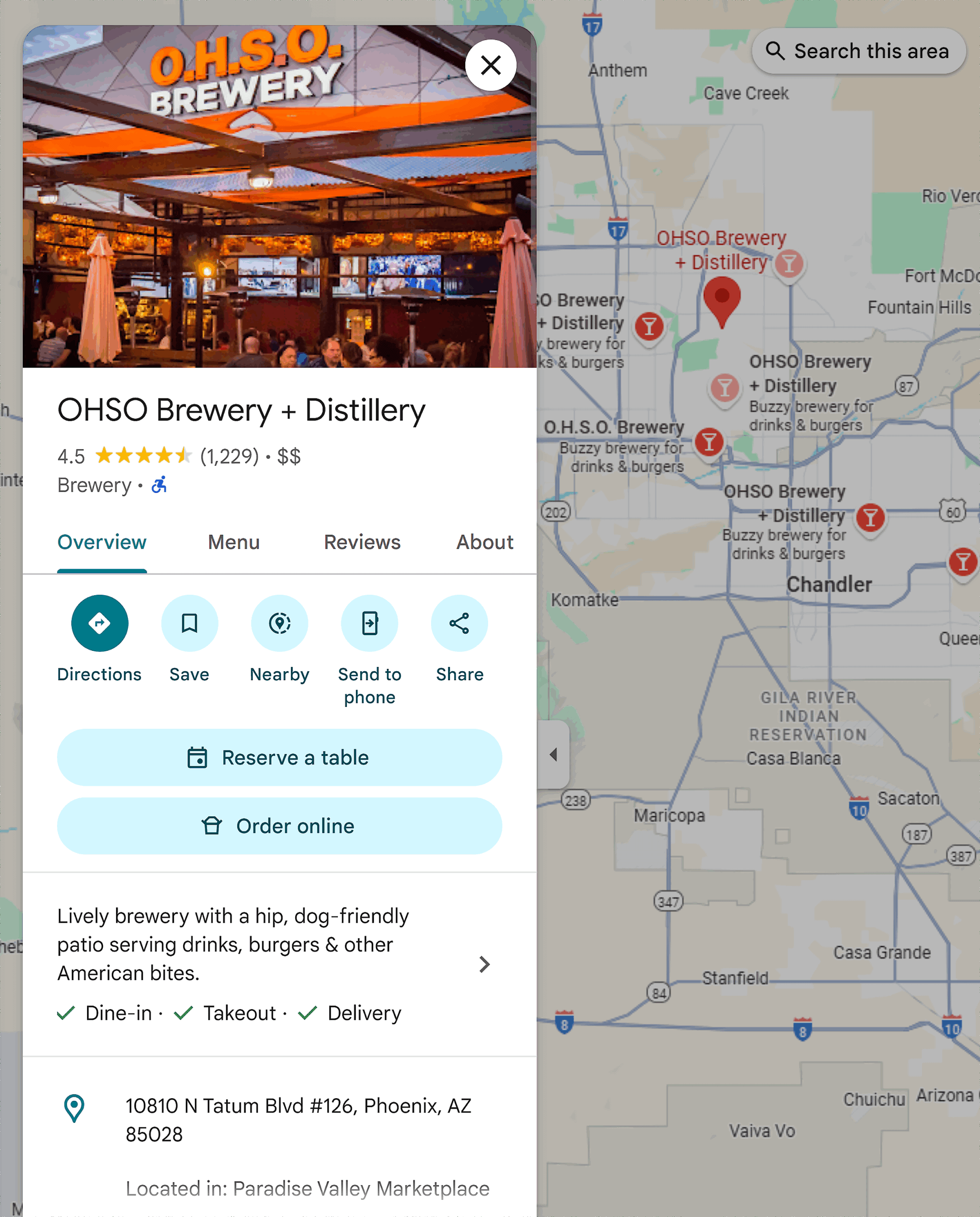
Then, display these clearly on your site.
But don’t just collect these reviews. Make sure you respond to them, too. And not just to the positive ones.
If you receive a negative review of your brand, then respond in a helpful and transparent way.
Apologize for what happened and offer advice or accurate information that could help resolve the issue or show how you handled it.

If you see a positive review, thank the user for the review and their business.
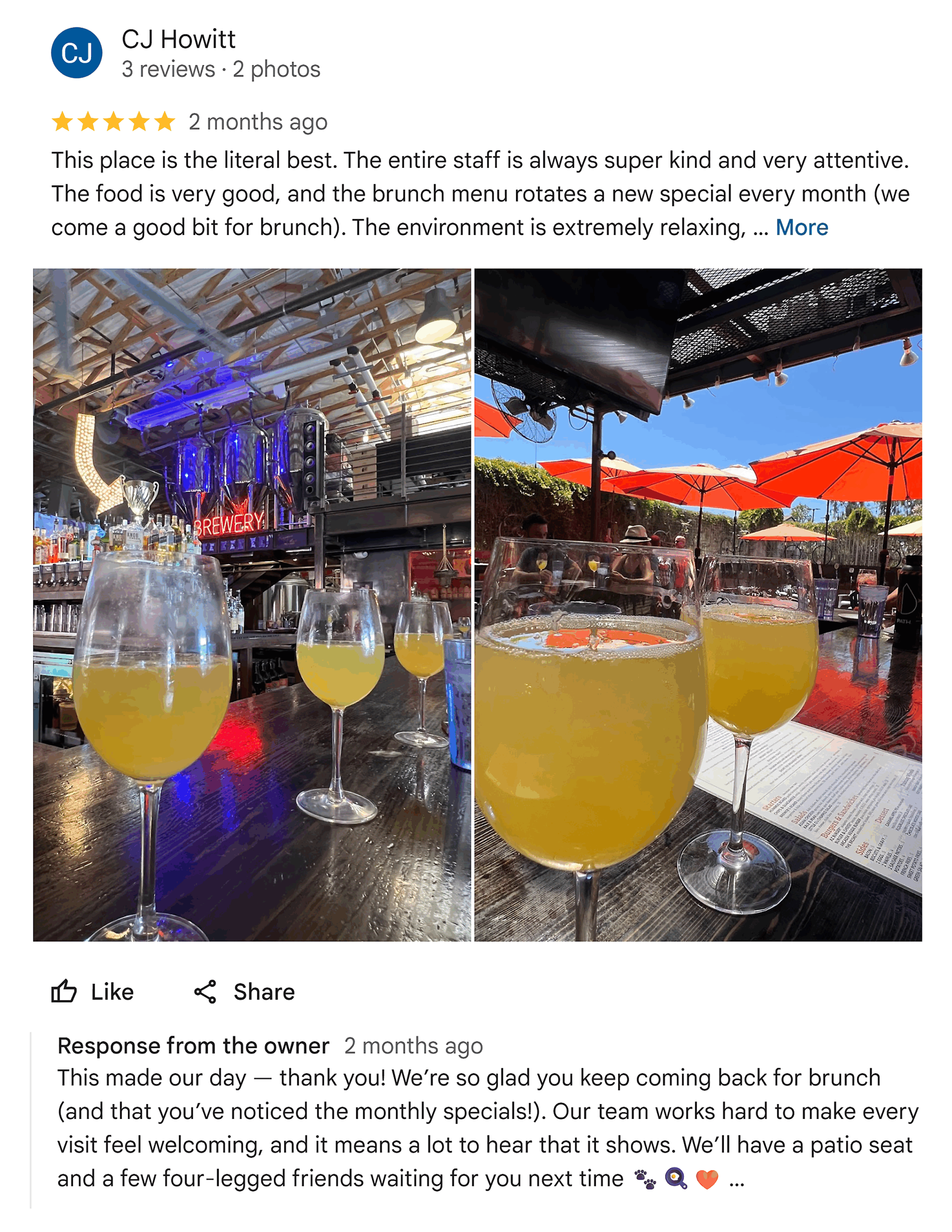
Keeping track of your reviews can be a bit of a pain.
You can use Semrush’s Review Management tool to make the process easier.
To start, type in the name of your business.

You’ll then need to add your business details.
Once you do that, you can view your company’s star ratings in a neat little graph.

If you scroll down, you can view all of your reviews and click on them to take you to the site where the review was posted.
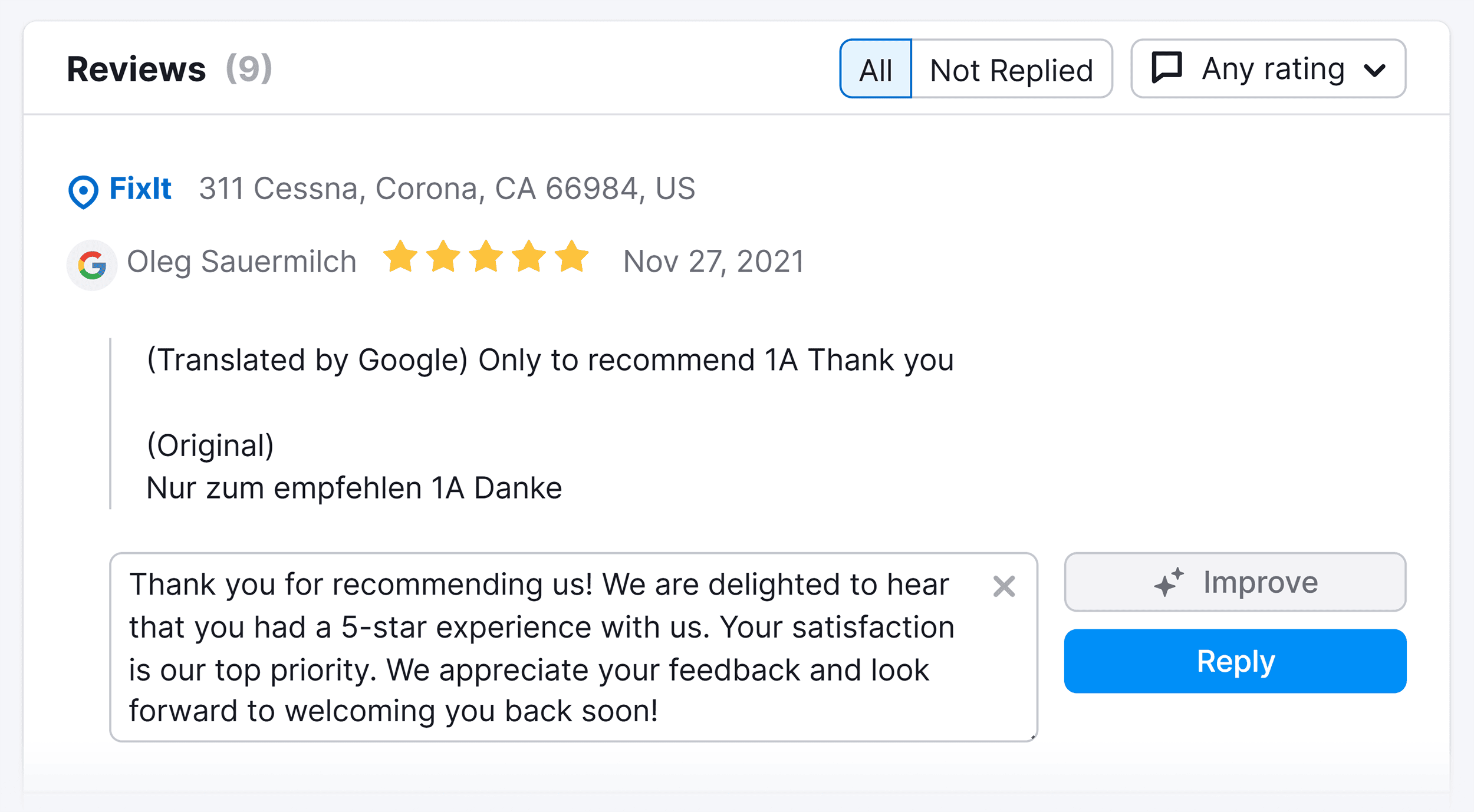
This allows you to respond to all the reviews more easily.
You’ll also want to keep an eye on brand sentiment.
A pattern of positive reviews and authentic customer experiences across multiple platforms signals trustworthiness to AI systems faster than it might impact your Google rankings.
This makes consistent reputation management across all channels — not just your website — vital.
Semrush’s AI Visibility Toolkit can help you monitor this metric.
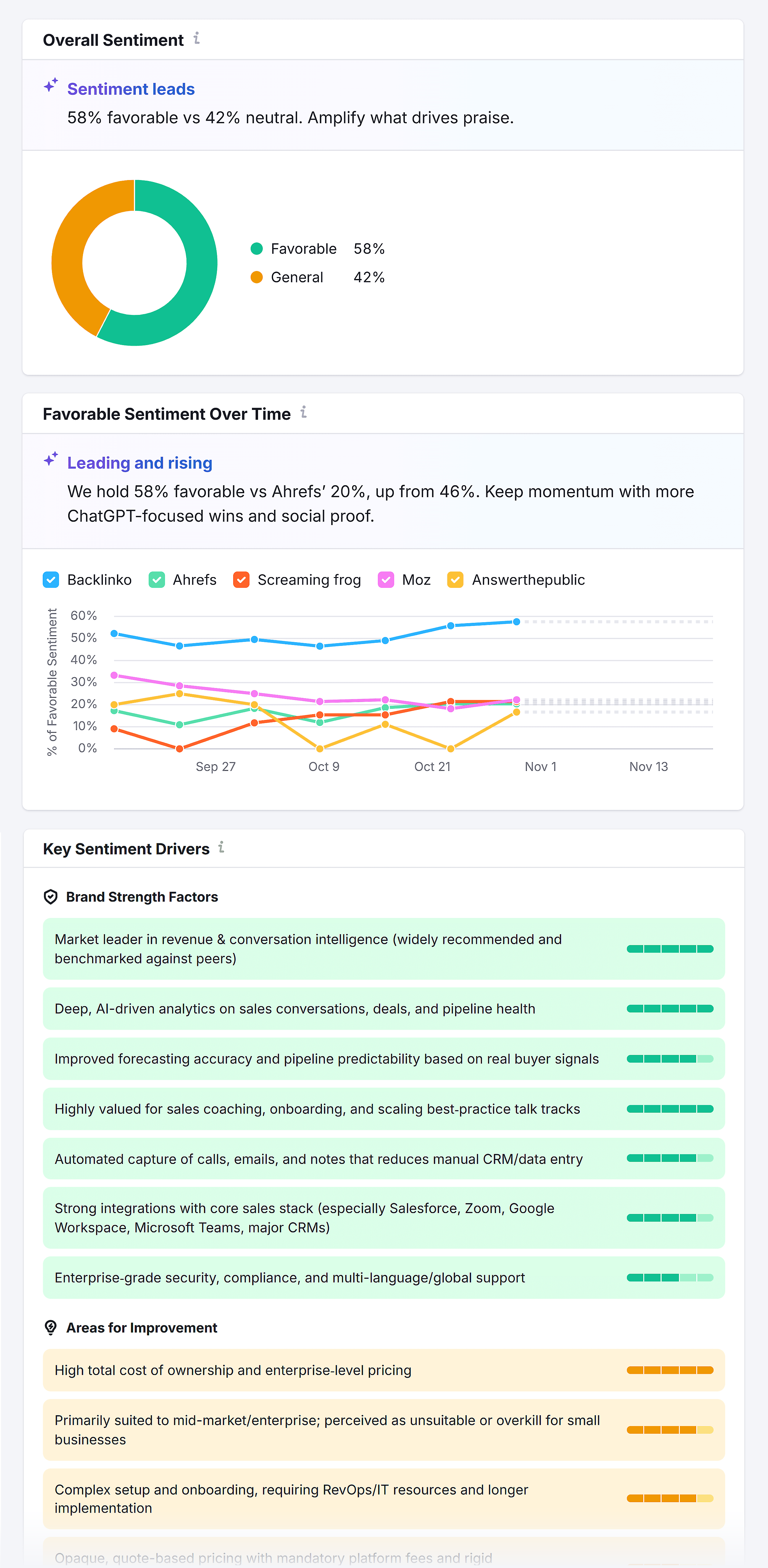
It shows how your brand sentiment stacks up against competitors across ChatGPT, AI Mode, Perplexity, and Gemini.
So, you can devise a strategy to improve or maintain your standing based on what the data reveals.
Think of this as understanding the story LLMs are telling about you. Unlike Google, where your reputation is implicit in the results, AI platforms synthesize a narrative from sources and present it as a direct answer.
If that narrative includes caveats (“great for enterprises but expensive for small teams” or “powerful features with a steep learning curve”), that framing shapes perception in ways a SERP position never did.
Monitoring sentiment is about understanding how AI systems are describing your brand when you’re not in the room.
[Insert shortcode CTA for Semrush AI Visibility Toolkit]
6. Get Your Brand and Team Featured in the Press
We’ve already discussed how important it is to have others refer to your experience and expertise.
It’s as essential as doing this yourself.
One of the most effective ways to do this is to get your brand and people featured in the press.
This is known as digital PR.

PR builds brand awareness by putting your name in front of the right audience. More importantly?
Repeated exposure in high-trust environments makes your brand easier to recall when it matters.
Brand awareness means people know who you are.
Brand salience means they think of you first when it’s time to buy (more on this below).

Digital PR includes:
- Sharing insights and engaging in industry conversations to increase social shares, comments, and mentions
- Presenting at industry conferences and webinars
- Hosting or going on relevant podcasts as a guest to build awareness for your brand
- Participating in forums and groups where your audience gathers
- Being a spokesperson for your industry. Offer valuable insights, comments, or knowledge to journalists using a site like HARO to share your expertise in some of your industry’s top publications.
- Using LLM seeding to increase citations in LLMs like ChatGPT, Perplexity, Claude, and Gemini. These mentions help boost visibility and brand authority.
As your brand gets mentioned in reputable publications, communities, and podcasts, you’ll naturally earn high-quality backlinks that improve your E-E-A-T signals.
7. Build Brand Salience (Not Just Awareness)
Another way to build E-E-A-T? Work on building your brand salience.
Brand salience is your brand’s ability to come to mind when a consumer is making purchasing decisions.
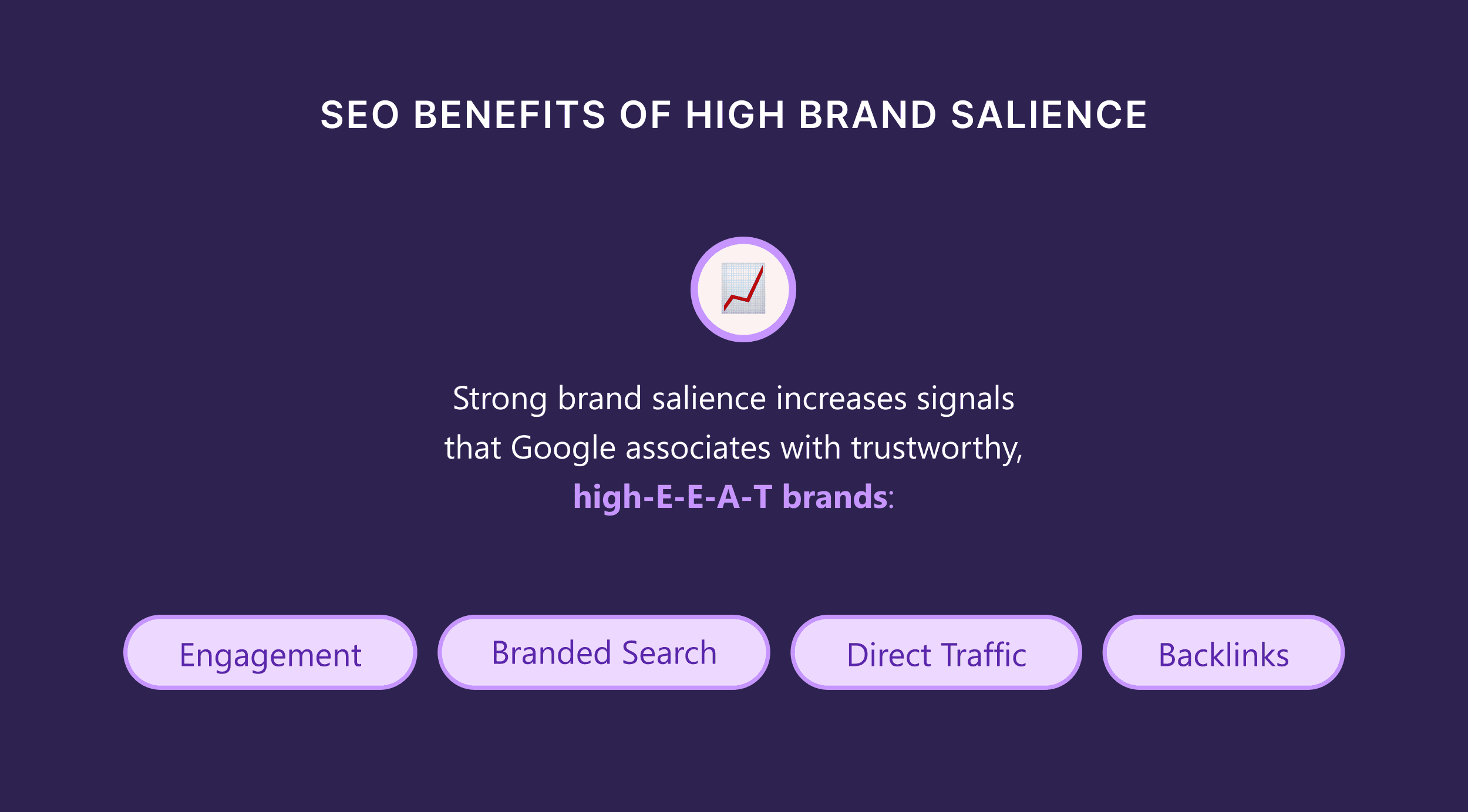
Think: Starbucks for coffee. Kleenex for tissues. Google for search.
These brands aren’t just well-known — they’re thought of at the most crucial moment — the buying decision.
In SEO terms, high brand salience increases branded search, direct traffic, engagement, and backlinks — all signals that Google associates with trustworthy, high-E-E-A-T brands.
So, how do you build it?
Get your brand in relevant contexts and decision moments:
- Create distinctive assets. Use consistent visuals, taglines, and naming conventions across channels so your brand becomes instantly recognizable and easy to recall
- Create content that aligns with buying moments. For example, if you’re a SaaS brand targeting consultants, publish comparison guides like “Best SEO Tools for Agencies.” But be honest in these comparisons. Acknowledge your tool’s pros and cons alongside competitors. Authentic, balanced reviews build more trust than self-promotional content that ranks your product #1 regardless of context.
- Be present across relevant touchpoints. Brand salience grows when you show up consistently — in SERPs, inboxes, social media, forums, and conversations your audience trusts.
There’s another layer here specific to AI visibility: appearing in AI-generated answers itself builds brand authority.
Just as ranking #1 in search results created a perception of leadership, being referenced by ChatGPT or Google AI Overviews signals credibility to users who trust these platforms.
But unlike ranked results, AI mentions come with context. Being recommended as “the industry standard” carries a different weight than being mentioned as “a budget-friendly alternative.” The goal isn’t just visibility — it’s being visible in the right frame.
Further reading: 19 Effective Digital Marketing Tactics
8. Make It Easy To Find Out Who Created Your Content and What Their Background Is
Users should easily see who created a piece of content.
This could be one author or many. They should also see the authors’ backgrounds.
The same goes for anyone reviewing the content.
In other words, someone shouldn’t need to search Google or social media to find out if an author is qualified to write on a topic.
Here are a few things that you can do to make this easier:
Create Standalone Author Profile Pages
Create standalone author profile pages for every individual who authors, contributes to, or reviews content.
But don’t just default to a simple grid of that person’s posts.
Go one step further and build these pages out to be a comprehensive guide on that person, including:
- Who they are
- A profile picture
- What their experience is
- What their areas of expertise are
- How to contact them
- The posts they’ve authored
- Examples of where they’ve been featured in the press
On the Semrush blog, writers, editors, and contributors get a byline that links to an author page.

There, you’ll find the author’s bio, photo, expertise, and education.
Under the author’s name and title, there are links to X and Linkedin for social proof.
And links to the author’s past articles on Semrush to reinforce entity signals.
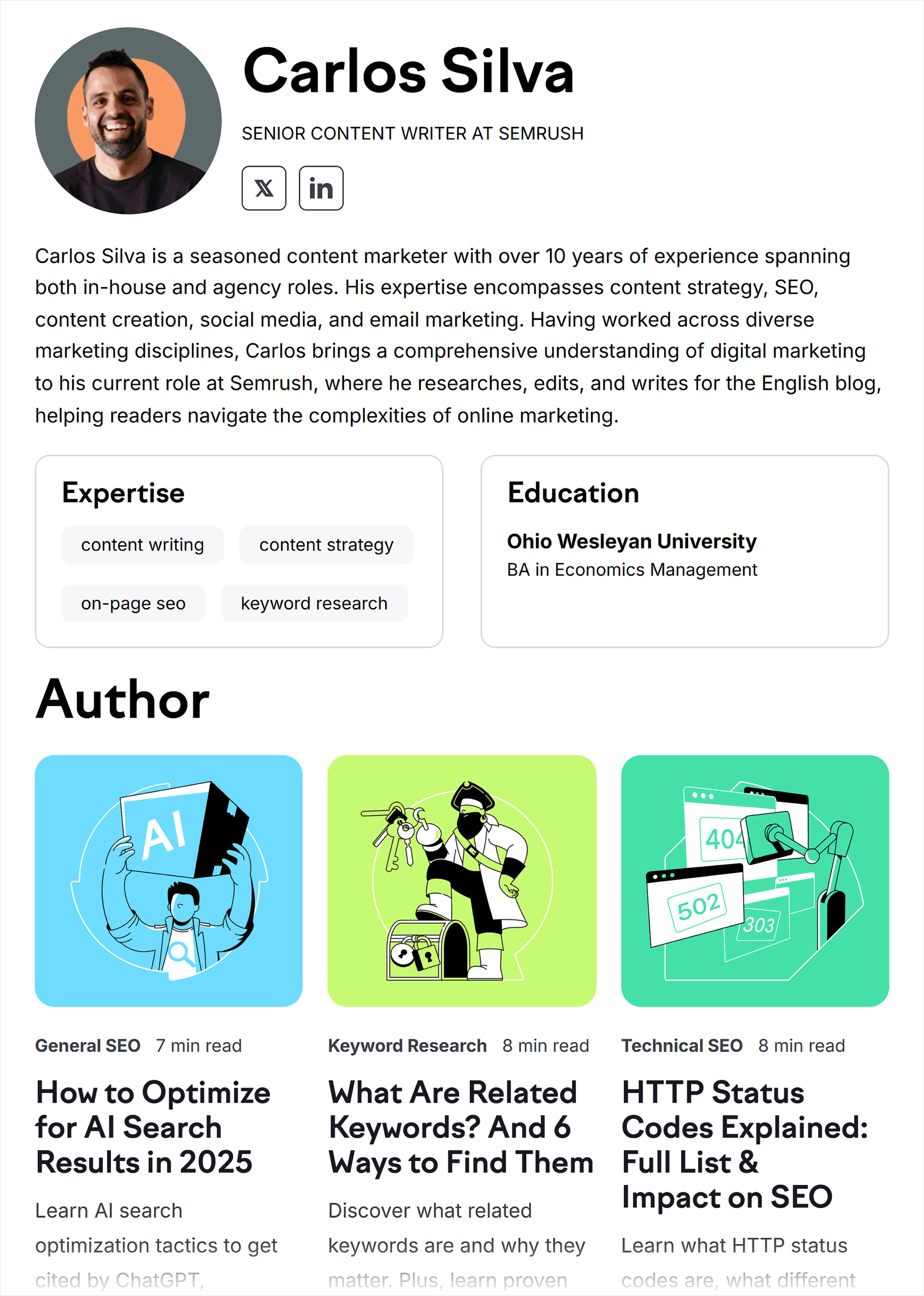
The more you can tell readers about who a particular author is and why they’re qualified to write about the topic, the better.
Need more inspiration?
Nerdwallet has some of the best author profile pages out there:
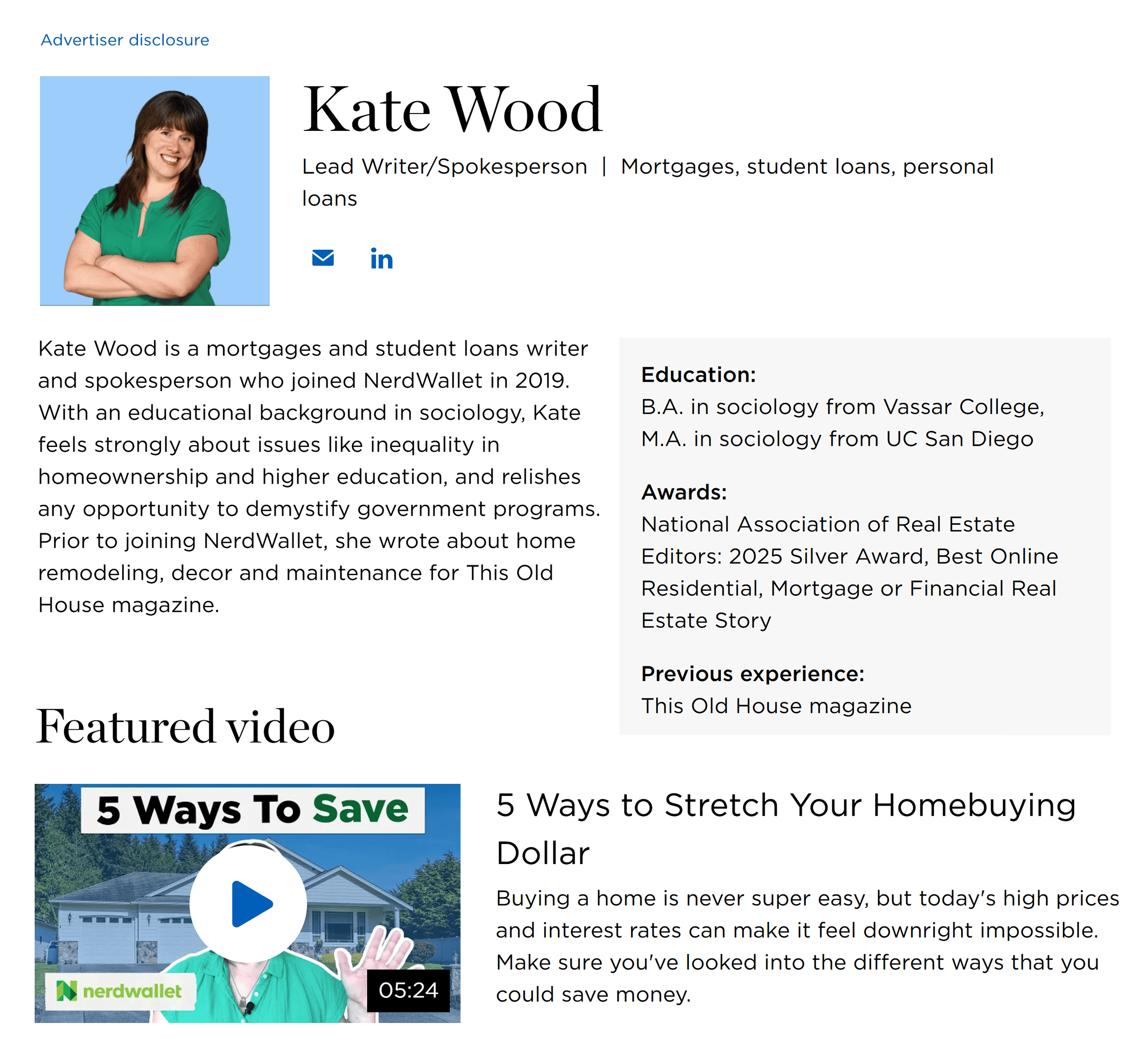
Use Schema Markup
Use schema markup to show who an author is and share their author profile page information with search engines.
There are two types of schema you should be using:
- The author property to define who the author of a piece of content is
- The ProfilePage Type on your author profile pages
Google announced support for ProfilePage structured data to showcase more information about the author (e.g., their name or social media profiles).
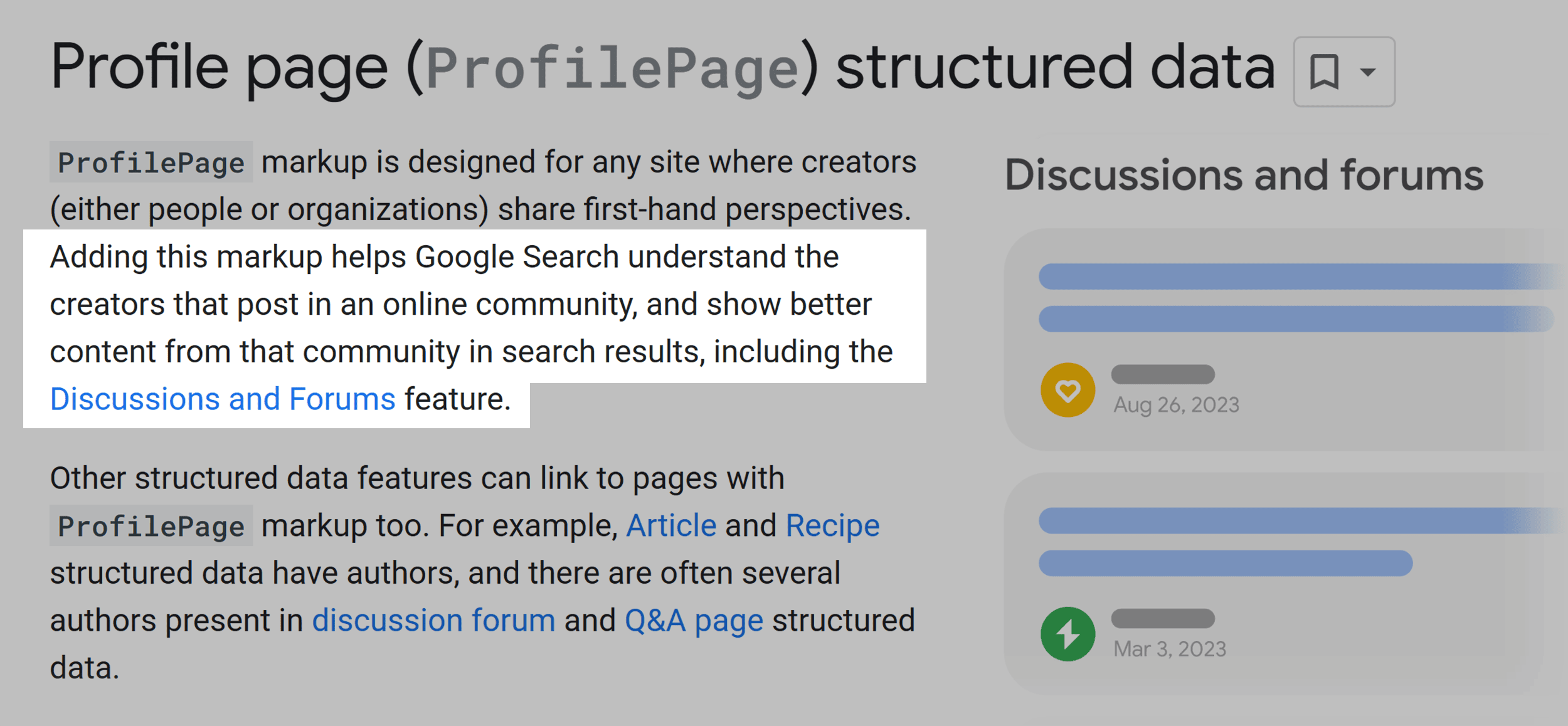
See these two examples from the Schema.org library for help implementing this:
9. Improve Your About Us Page
Your About Us page is the perfect place to tell your brand’s story.
Google’s Quality Rater Guidelines actually suggest this as the starting point for Quality Raters to find out what a website or content creator says about themselves.
Your About Us page should be your website’s showcase of who you are, what your background is, and how you’re different.
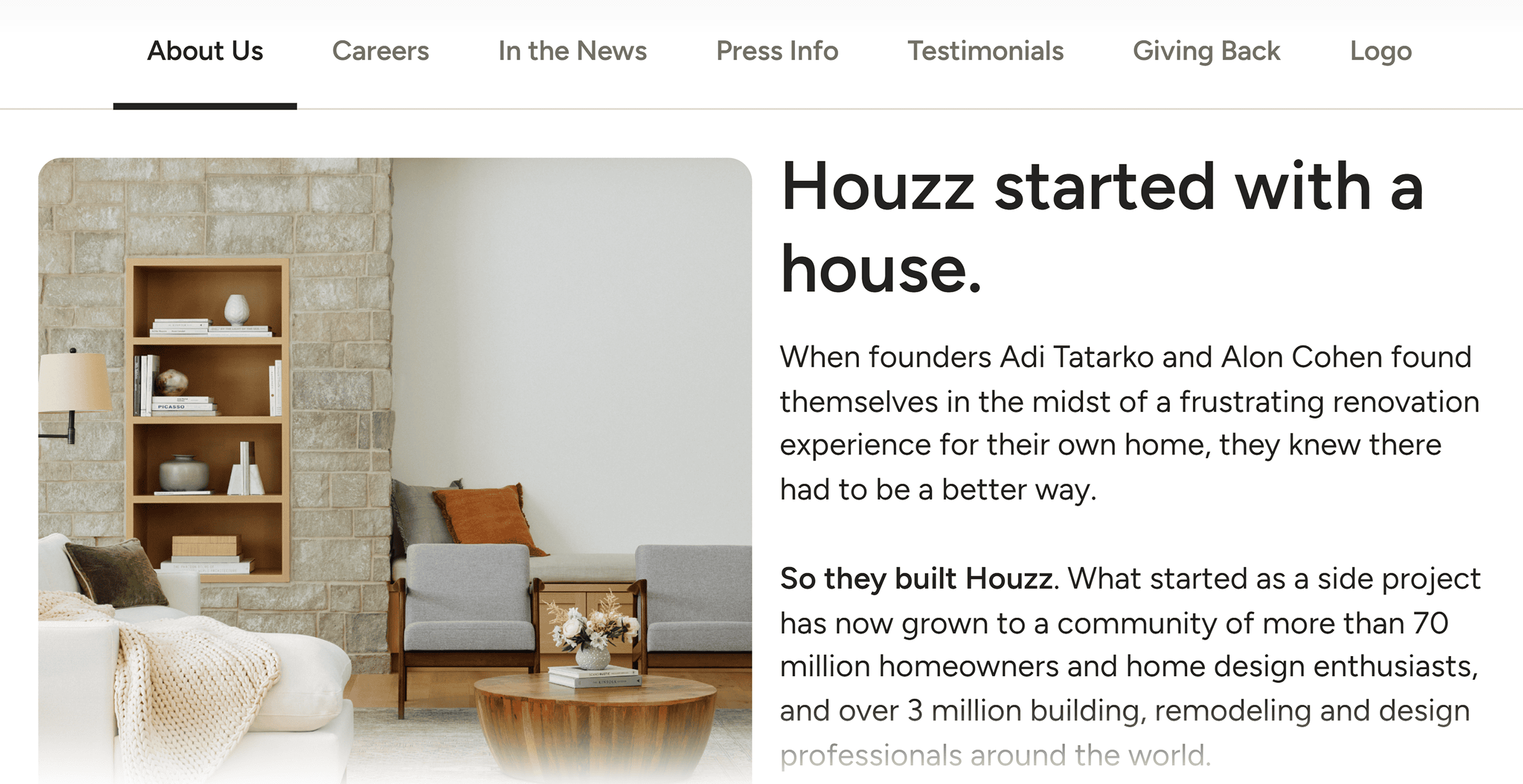
Consider including some or all of the following things on your About Us page:
- Your story
- Your product and service offering trust factors
- Your unique selling proposition (USP)
- Your team
- Your awards, professional memberships, and accreditations
- Your reviews and testimonials
- Your locations
- Your contact information
- Your clients and customers
Pro tip: Ensure consistency across all platforms. The information on your About Us page should align with what appears on your social profiles, press mentions, review listings, and other properties.
When your brand story, offerings, and key details are consistent everywhere, it helps both Google and AI platforms confidently understand and cite your business.
10. Demonstrate Basic Business Trust Factors
Don’t overlook the basics that visitors expect to see when they land on a business website.
Things like:
- Terms and conditions page
- Privacy policy page
- Cookie policy page
- Returns policy page
- Shipping windows and information
- Delivery information
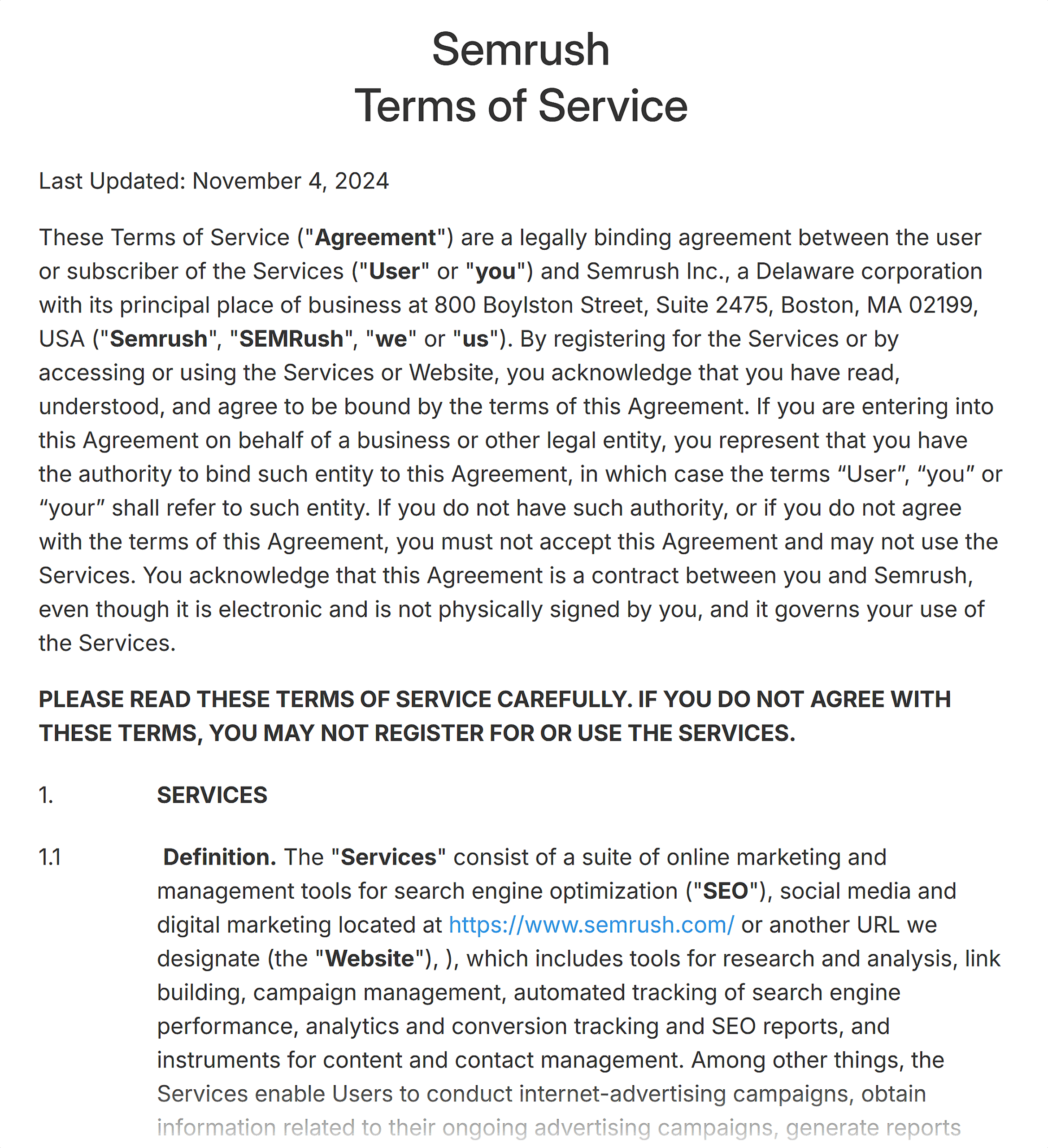
While it might seem obvious that you need to have these pages in place (with some of them even being legal requirements), not having them is a huge red flag.
Would you trust an ecommerce website that didn’t have a clear shipping and returns policy?
Doubtful.

It’s not that having these things in place sets you apart from others. Because it doesn’t.
But, the lack of these basic business trust factors strongly suggests that a site could be fraudulent or untrustworthy.
You also need to make sure that your contact information is easy to find. This means having a contact page listing your
business’s:
- Phone number
- Email address
- Chatbot information
- Physical address (if you have one)
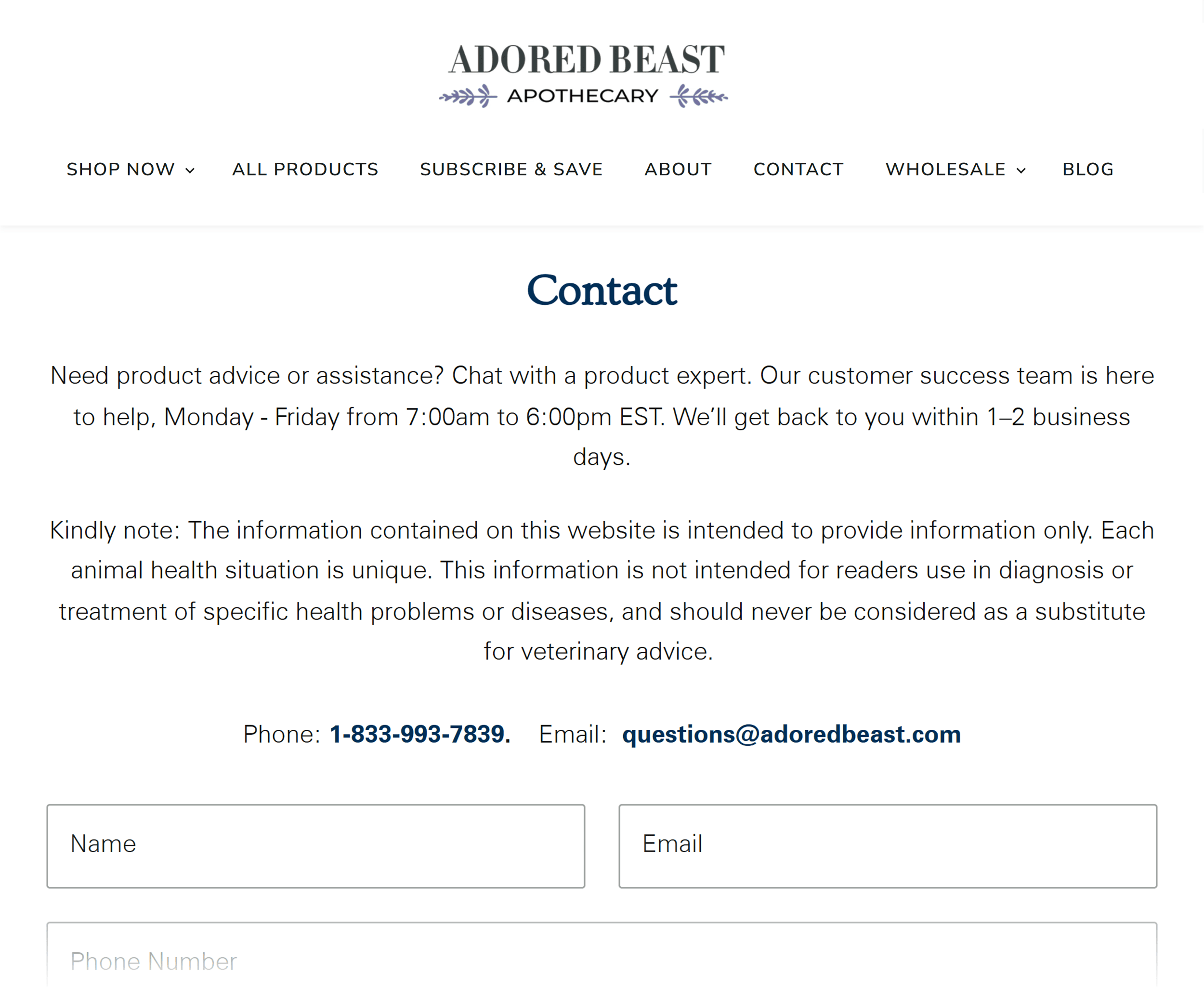
11. Optimize Your Site’s Technical Foundation
Your site’s technical health directly impacts how trustworthy it appears to users and Google, and LLMs.
Essential technical trust factors include:
HTTPS Security
If your site doesn’t use SSL (Secure Socket Layer) encryption or HTTPS (Hypertext Transfer Protocol Secure), users are unlikely to trust you.
Check that your URL starts with “https://” and displays a lock or tune icon, depending on your browser.
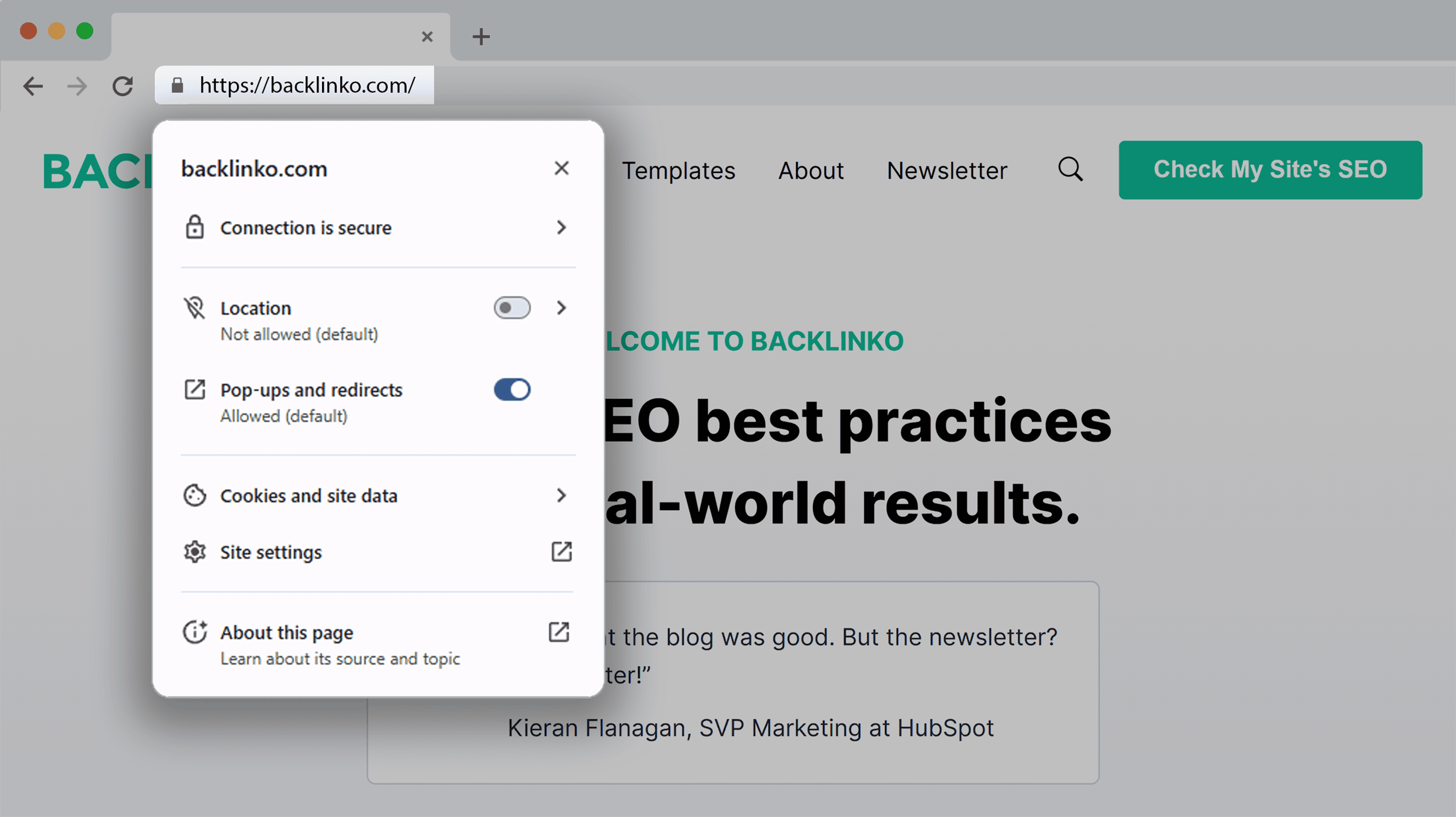
Site Speed
Optimize for fast loading times on desktop and mobile by compressing images, minimizing plugins, and using a content delivery network (CDN).
Aim for loading times under 3 seconds.
Use PageSpeed Insights, Core Web Vitals, and site audit tools to evaluate your site’s performance.
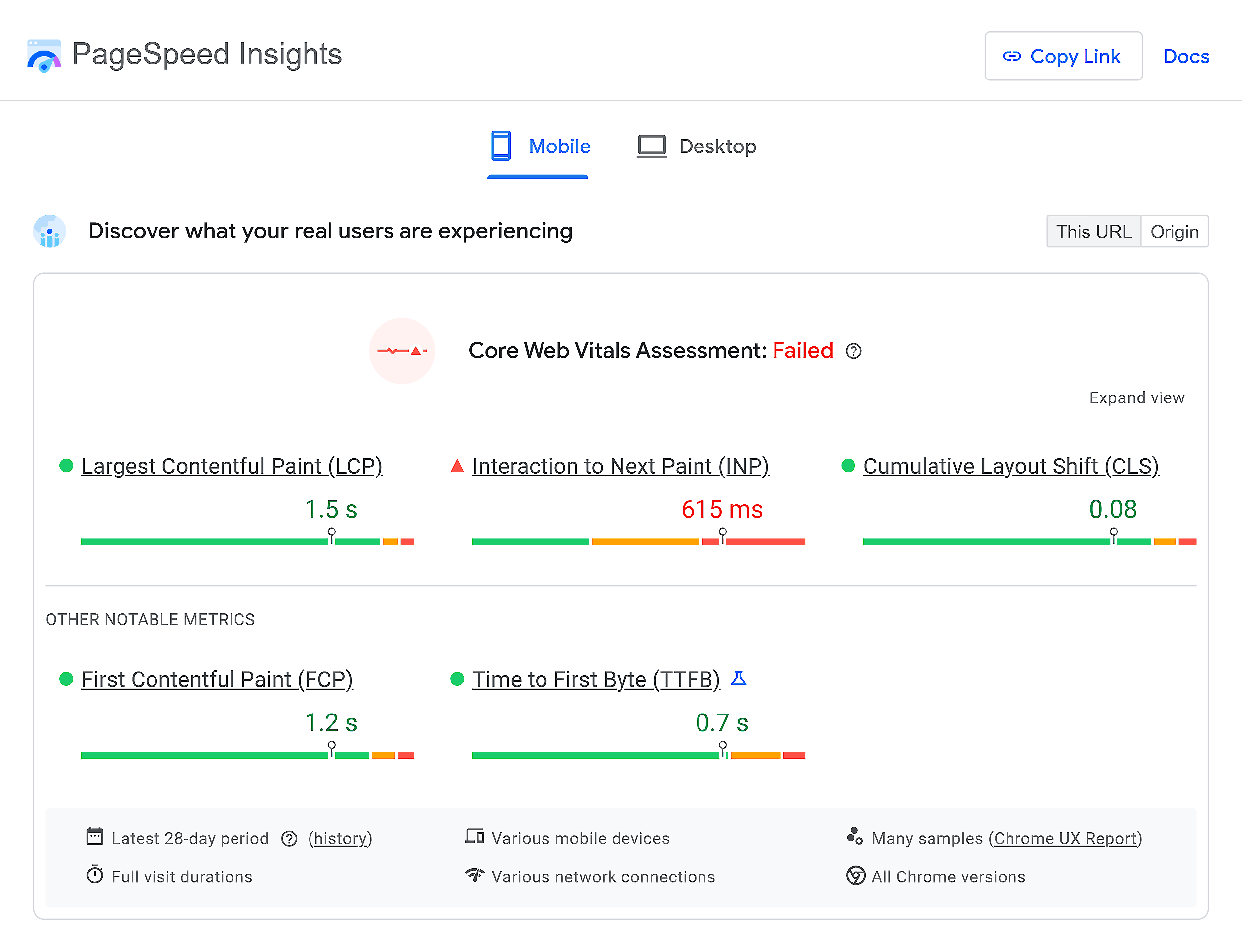
Mobile Responsiveness
Make sure your site works well on all devices.
Test your pages on different screen sizes and ensure buttons are easily tappable, text is readable without zooming, and navigation menus work smoothly.
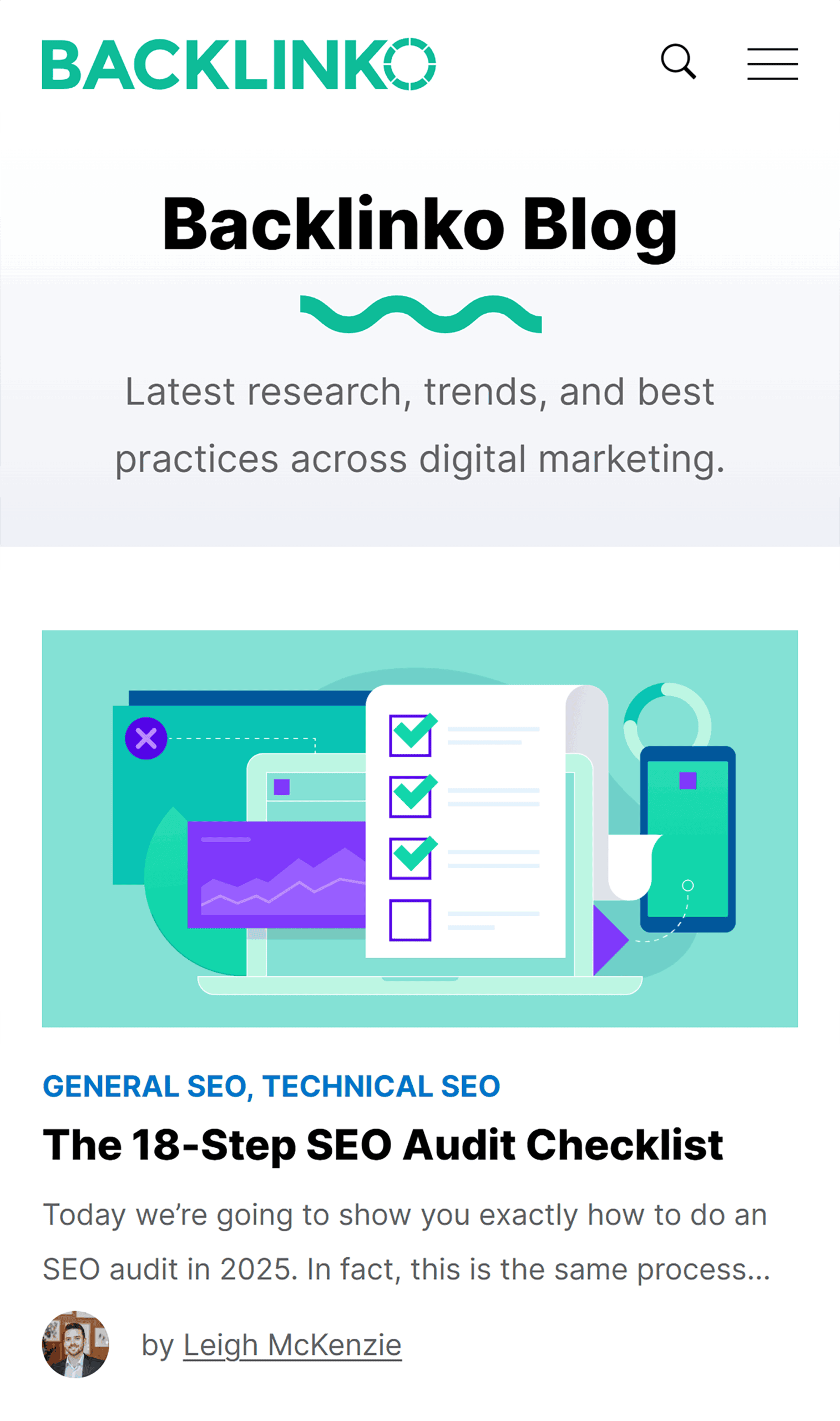
Clean Navigation
Create intuitive site structure with clear menu categories, breadcrumb navigation, and logical internal linking between related pages.
Users should be able to find any page within three to four clicks from your homepage.

Semrush’s Site Audit tool is a quick and easy way to assess your site’s technical health.
It alerts you to issues and tells you how to fix them so your site is always fast, user-friendly, and secure.
Here’s how to use it:
Enter your domain into the search bar and click “Start Audit.”
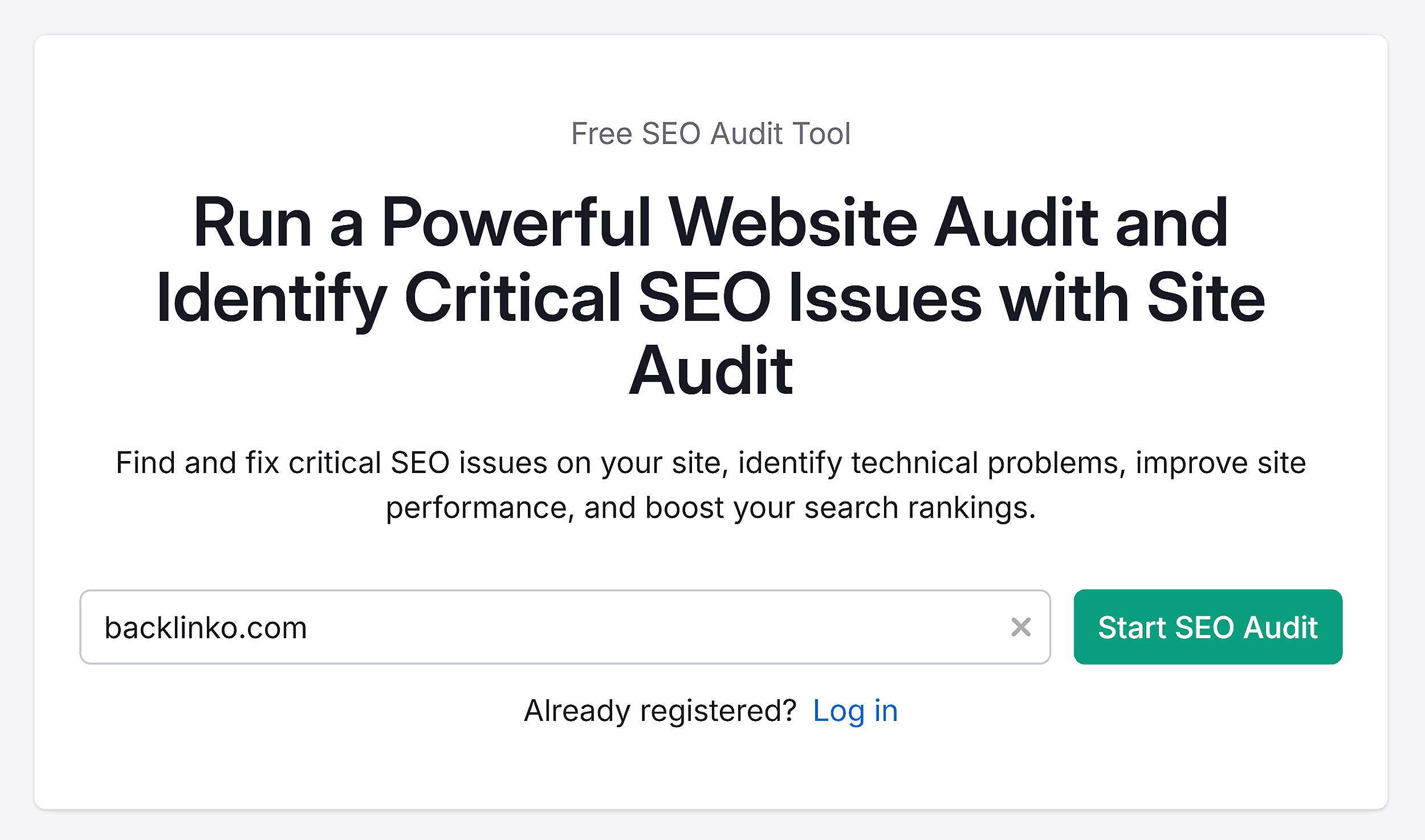
You’ll then be taken to the “Site Audit Settings” menu.
If you’re happy to use the default settings, click “Start Site Audit.” Otherwise, configure the settings.
When the audit is complete, you’ll see an overview report.

Click the “HTTPS” widget under “Thematic Reports.”
Click on “View details.”

The tool then tells you:
- Your HTTPS Implementation score
- If your security certificates and server security are up to date
- How secure your site architecture is

If the audit detects any issues with the security of your site, you can click on the issue to learn more about how to fix it.

Spend some time clicking around the different areas of the report to learn more about your site’s health, from internal linking issues to slow pages.
See a lot of “Errors”?
These are the highest-priority issues the tool flagged on your site.
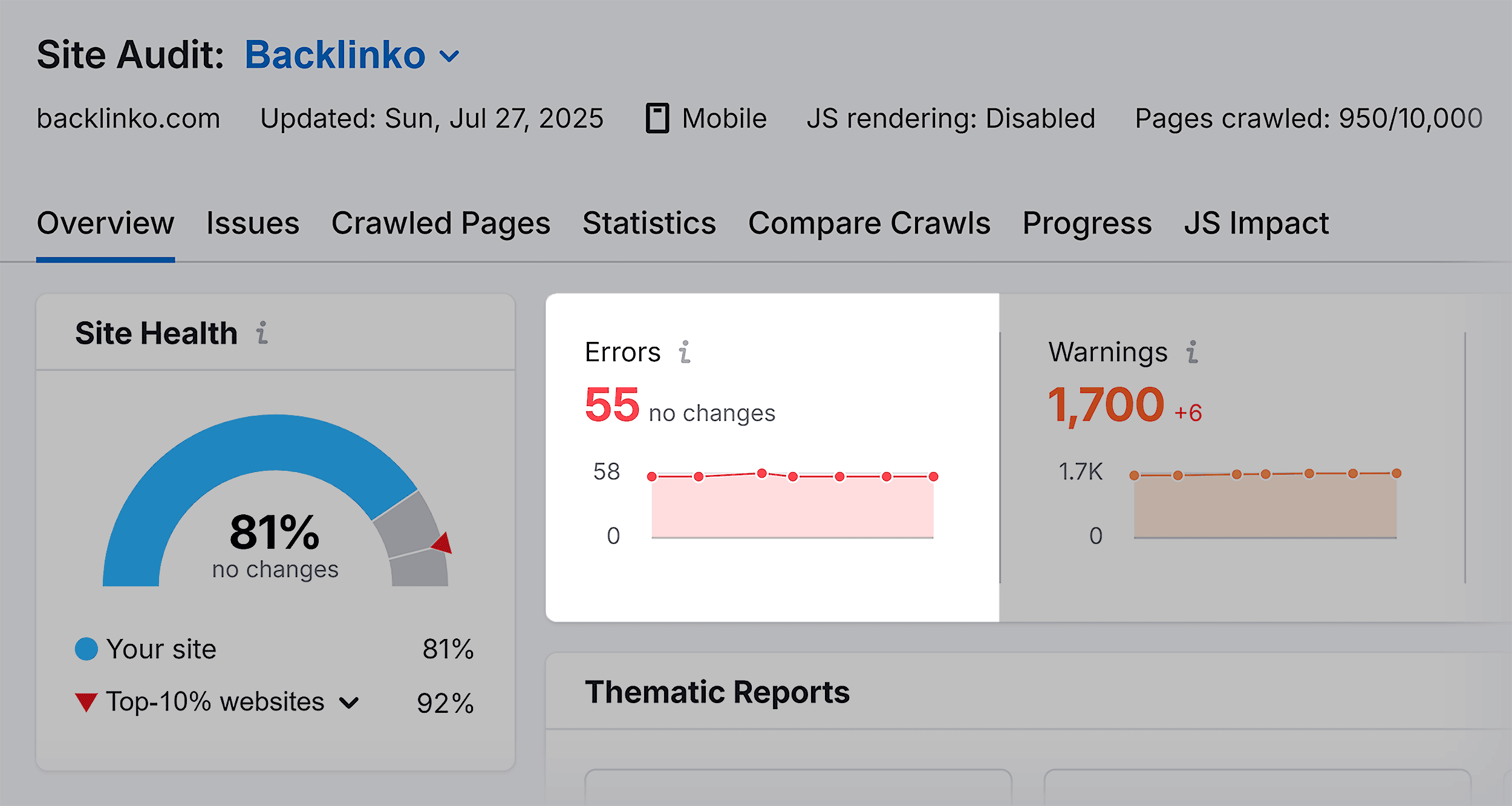
Fix these first to improve your site’s performance and user experience.
12. Cite Sources in Your Content
Clearly cite sources in your content. Link out to them, too.
It’s sometimes hard to trust claims, statistics, or facts found online. This is often because there’s no clear reference to where the information came from.
Is the information from your own data? Make it clear.
For example, this Semrush study about Google’s AI mode includes a detailed “Methodology” section that explains exactly what they analyzed.
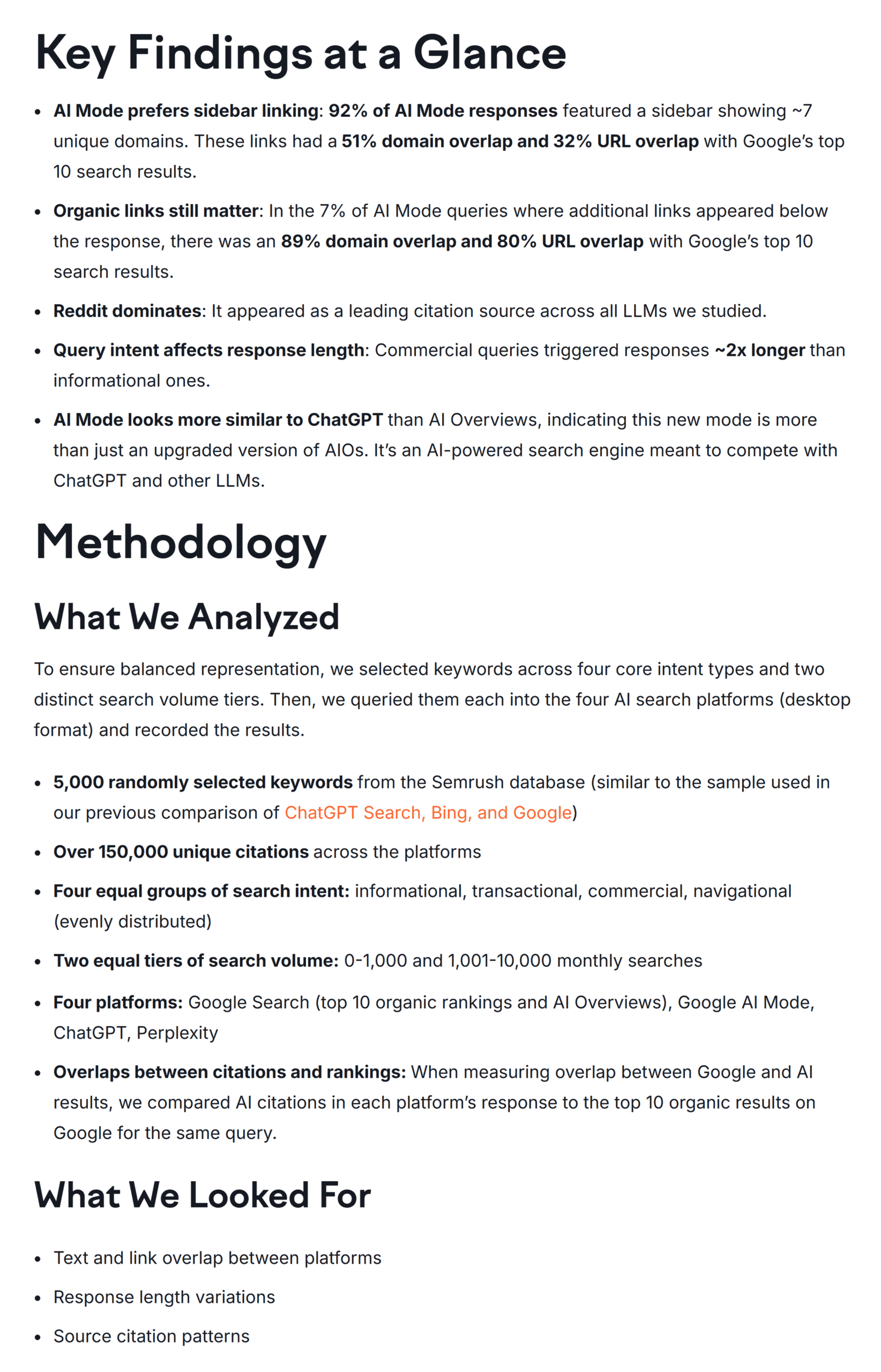
This transparency shows readers that the information is trustworthy.
It also shows Google you’re conducting legitimate research rather than making unsupported claims.
Was the information sourced from someone else’s research or content? Make it clear.
And link to the original source.
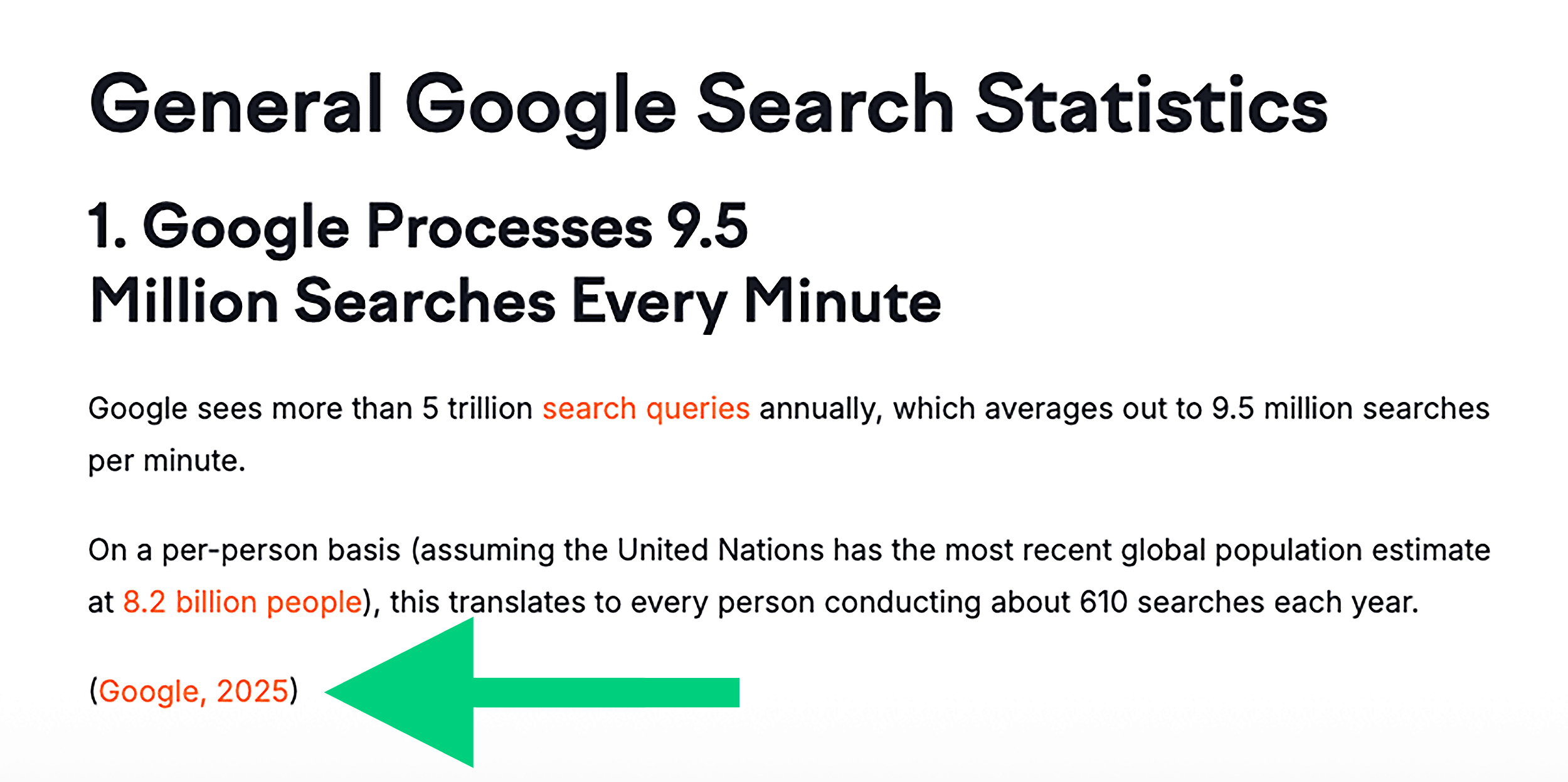
When selecting sources, stick to well-known, industry-leading sites, .gov or .edu sites, and expert quotes.
Always assess the sites for the E-E-A-T signals we talked about here to ensure you are citing accurate data and information.
13. Use Your Own Images and Video Content
How can you demonstrate that you’ve actually experienced the thing you’re writing about?
Use your own images, videos, or other media.
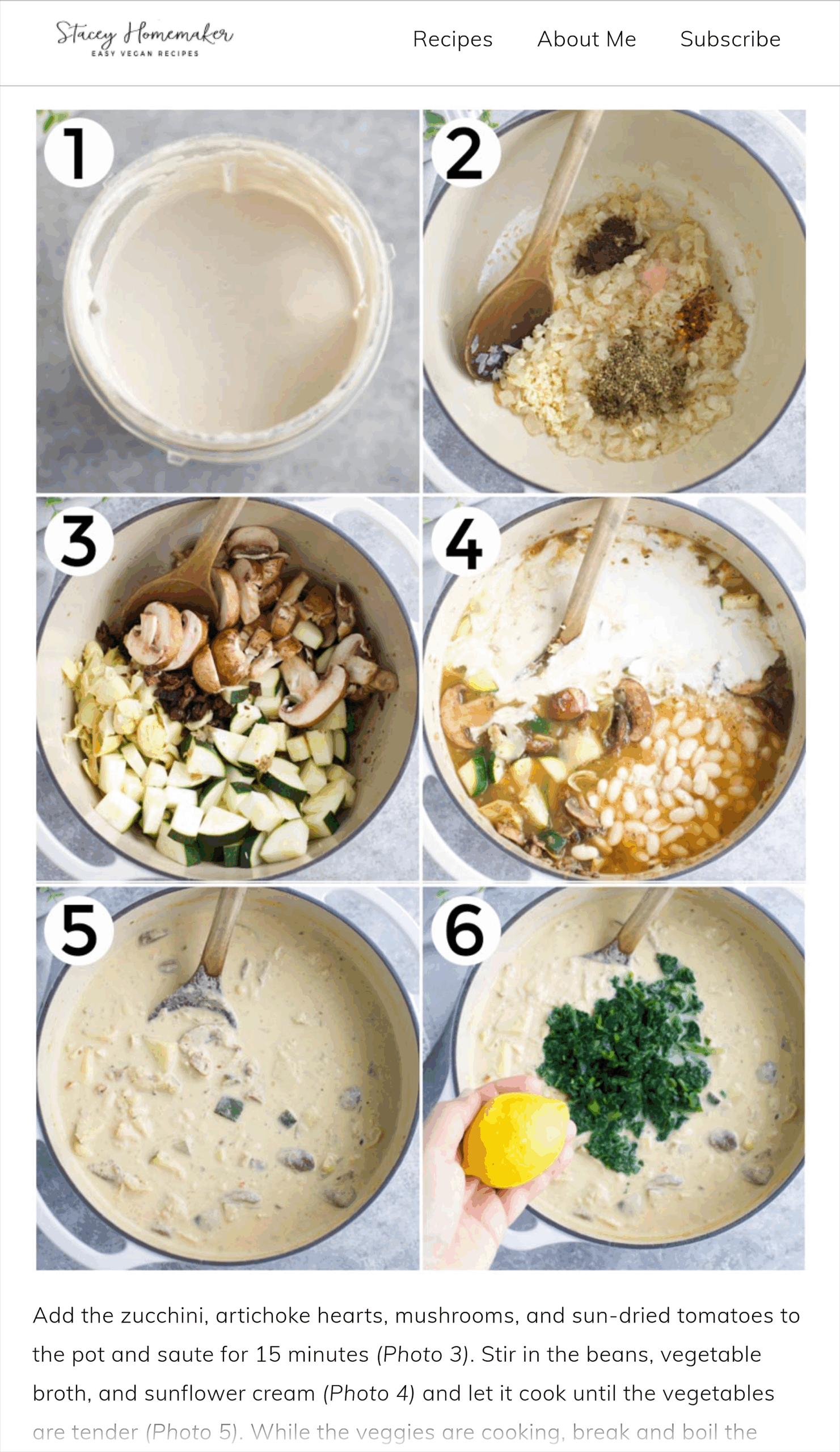
Using stock images does nothing to demonstrate this.
(And it’s a pretty strong sign you don’t have the experience you’re claiming you do.)
Don’t assume you need to hire a professional photographer, though.
Photos taken using your smartphone are usually more than good enough.
Here’s an example:

14. Keep Your Content Updated
An authority on a subject wouldn’t allow their content to become outdated.
A page that hasn’t been updated recently likely contains old or inaccurate information.
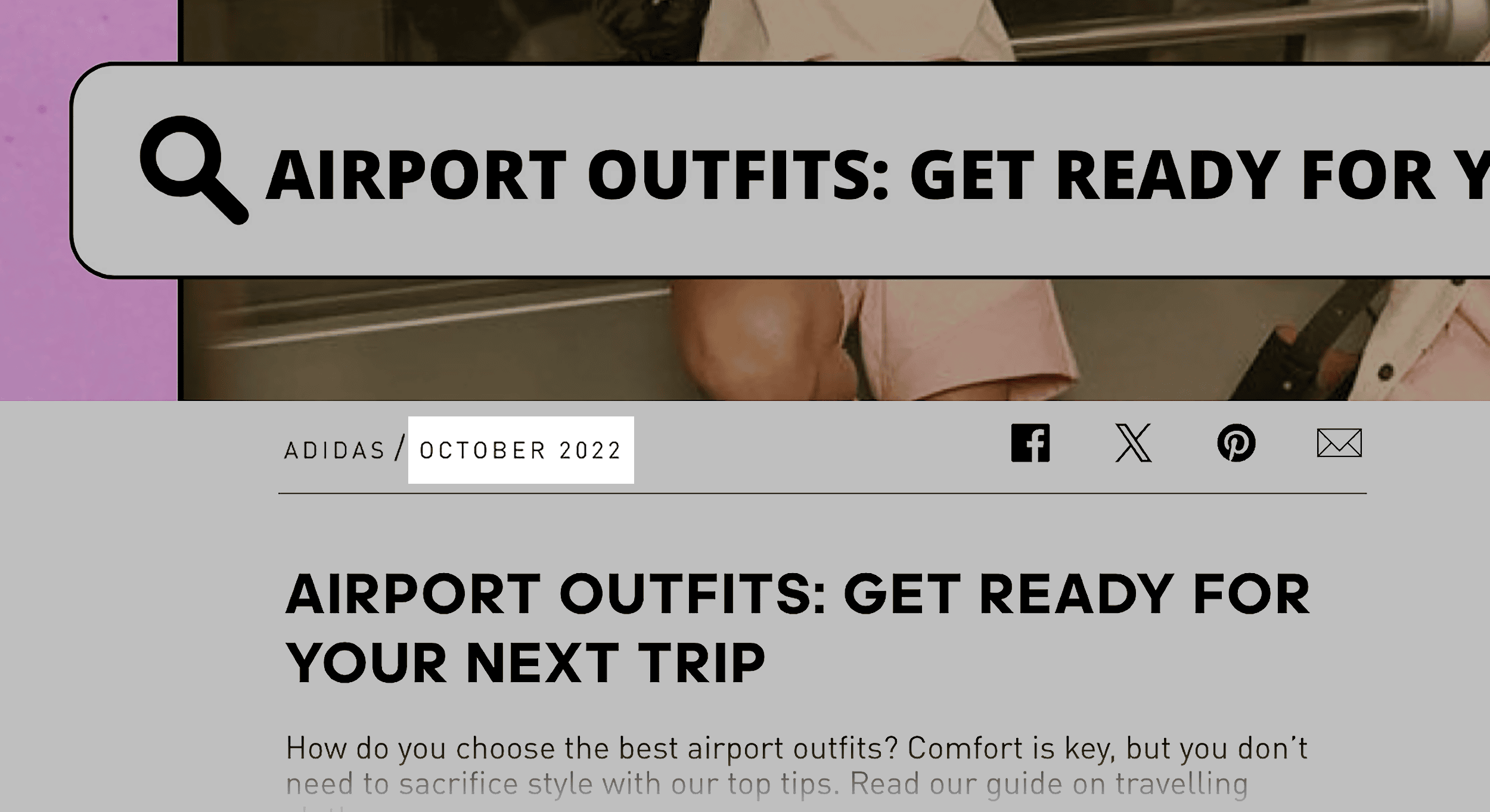
Review your site’s content regularly and update it as information changes on a topic.
Generally, we aim to review content at least once a year (ideally every six months).
But don’t just review and make edits without telling anyone.
Show the date when the content was last reviewed and updated. This can go a long way in helping users trust that the content is accurate.
Here’s what this looks like on Backlinko:

It’s really easy to see how recently this was updated.
What Hurts Your E-E-A-T
While there are many ways to build trust and authority, there are just as many ways to lose it.
Google’s Quality Rater Guidelines describe low-quality pages as ones that demonstrate little to no E-E-A-T.
And in some cases, that can tank your perceived credibility, regardless of the rest of your site.
It can also destroy your chances of being cited and recommended by AI search engines and LLMs.
Here are some common E-E-A-T killers:
- Poor quality content that hasn’t been created with adequate originality, talent, effort, or skill
- Slightly exaggerated, shocking, or misleading titles
- Sites or content creators with mildly negative reputations
- Thin information about the content creator or site
- Ads or supplementary content that distract from the main content of the page significantly
- No off-page validation — if no one is linking to or mentioning you, it’s harder for Google and LLMs to verify your authority
Let’s look at an example of a page that meets at least one of these criteria.
This article is titled “40th Birthday Party Food Ideas.”
At the top of the page, you can see some of the content.

It’s poorly written and contains errors, clearly showing a lack of effort and skill.
But it gets worse.
When you scroll down, you’re met with several ads.

It’s fair to say that Google’s raters would classify those ads as distracting from the page’s main content.
So, even if the rest of this site is fairly reputable, this page is almost certain to get a low E-E-A-T rating.
Frequently Asked Questions About E-E-A-T
Here are answers to some of the most frequently asked questions about E-E-A-T.
What is YMYL content, and why is E-E-A-T crucial for it?
While E-E-A-T is essential for every website, it’s crucial for those dealing with “Your Money or Your Life” topics.
These pages could have severe implications for people’s health and financial stability if the information provided is inaccurate or the sites are untrustworthy.
There’s a much stronger need for content created by people with adequate expertise.
Some examples of YMYL niches include:
- Finance
- Healthcare
- Legal
- News and current events
If you’re running a site in a YMYL niche, it’s vital that you follow E-E-A-T principles and expect to build and demonstrate many more signals than other sites.
Your audience needs to be able to trust the information you provide, and you need to minimize the risk of causing harm to readers.
Can you fake E-E-A-T signals?
E-E-A-T isn’t something you can fake, nor is it something that you should try to fake.
Remember that E-E-A-T involves building and demonstrating the signals that Quality Raters look for, and that these are things you simply can’t fake.
Why?
Building a positive reputation is about what other people say about you.
Sure, you can fake what you say about yourself, but this isn’t going to be confirmed by other third-party reputable sources.
Are there any specific tools available to assess a website’s E-E-A-T level?
No, there aren’t any tools available that can assess your site’s E-E-A-T level.
Because E-E-A-T isn’t a single, measurable ranking factor, there’s no E-E-A-T score and nothing that a tool could measure.
But many SEO tools use signals like backlinks, citations, and author visibility to help estimate site credibility, which gives you a solid idea of where you stand.
For example, Semrush’s AI Visibility Toolkit tracks brand sentiment (positive, negative, neutral) and visibility across AI platforms like ChatGPT, Perplexity, and Gemini.
This helps you understand how your E-E-A-T signals are performing in AI search.
The best way to assess your site’s E-E-A-T level is to familiarize yourself with Google’s Quality Rater Guidelines and the levels included within them.
And compare your own webpages with the examples given and the criteria set out for raters.
How does E-E-A-T apply to user-generated content?
For user-submitted posts, E-E-A-T is judged individually. Standards are looser than the main page content, but moderation is still expected.
Excessive spammy, hateful, or false user content suggests poor site moderation and hurts E-E-A-T. Moderation is key for UGC sections, especially on YMYL topics.
Some low-quality UGC is okay, but a high ratio of junk content is an issue. Setting guidelines helps maintain E-E-A-T standards.
What are the most common E-E-A-T mistakes?
E-E-A-T is still a massively misunderstood SEO concept. This means there’s a lot of confusion and mistakes when building and demonstrating it.
The most common mistakes that we see made when it comes to E-E-A-T include:
- Creating fake authors
- Misrepresenting expertise
- Publishing low-quality content that’s a copycat of content already ranking in the search results
- Not building on-page and off-page signals
- Missing (or hard to find) contact information
- Not including references or links to sources within the content
- Outdated content
- No evidence of positive reviews for the business or products
- Not making it clear who wrote the content and their experience and expertise
- Failing to secure the site with an SSL certificate
- Using stock images
- Having a weak About Us page
What if you can’t get your business’s experts to write content?
If your experts can’t write content themselves, you can still collaborate with them to build strong E-E-A-T.
Here are your options:
- Schedule monthly expert interviews. Block out an hour or two each month to discuss the main topics you’re covering. Record these conversations, use them to write the content, then have the expert review it before publishing. List them as a reviewer on the page.
- Incorporate expert quotes. Write the content yourself, but weave in quotes and insights from experts throughout. This still leverages their expertise and adds credibility to your content.
- Work with third-party experts. If internal experts aren’t available, reach out to recognized authorities in your industry and feature their insights in your content.
Succeed with E-E-A-T in the AI Era
E-E-A-T signals matter more than ever.
Whether you’re trying to rank in Google or get cited by ChatGPT, experience, expertise, authoritativeness, and trustworthiness are non-negotiable.
The tactics in this guide will help you build credibility that carries across search engines and AI platforms.
Remember, ranking is just the beginning. Staying visible and authoritative means showing up wherever your audience searches.
Want to go deeper on AI visibility?
Read our guide to Generative Engine Optimization (GEO) to build your AI visibility strategy.
Backlinko is owned by Semrush. We’re still obsessed with bringing you world-class SEO insights, backed by hands-on experience. Unless otherwise noted, this content was written by either an employee or paid contractor of Semrush Inc.


